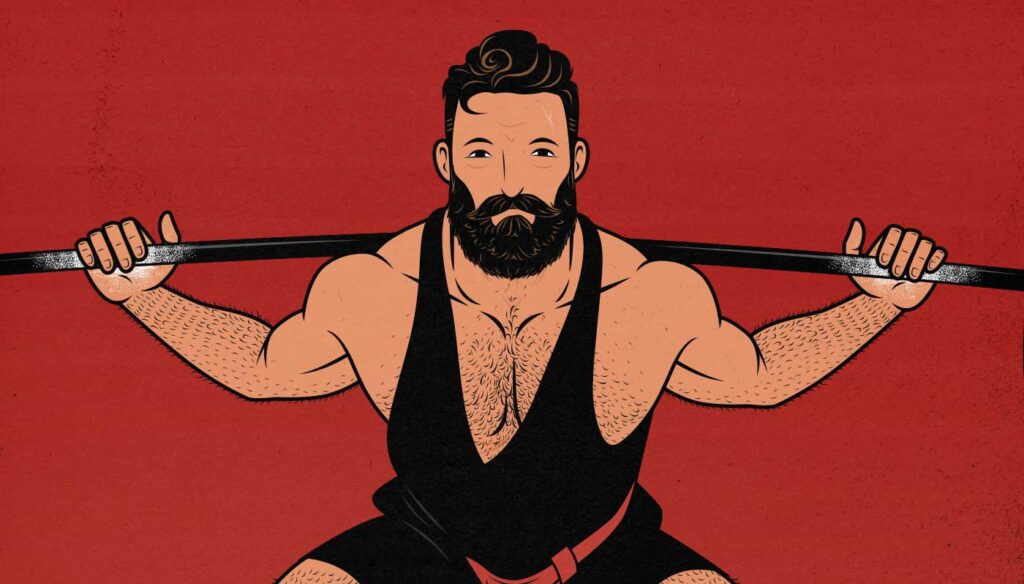
A Review of Starting Strength for Building Muscle
Starting Strength was created by the former powerlifter Mark Rippetoe as a beginner program for gaining general strength. It has its roots in powerlifting culture, but it’s not a powerlifting program. It’s designed to be good for gaining general strength, but what does that mean? And it’s occasionally marketed as being a good program for gaining muscle size. Is it?
What we want to do in this article is to review it from the perspective of a skinny person who’s new to lifting weights and trying to gain muscle mass, become stronger, and improve their appearance. Is Starting Strength ideal for those very specific goals?
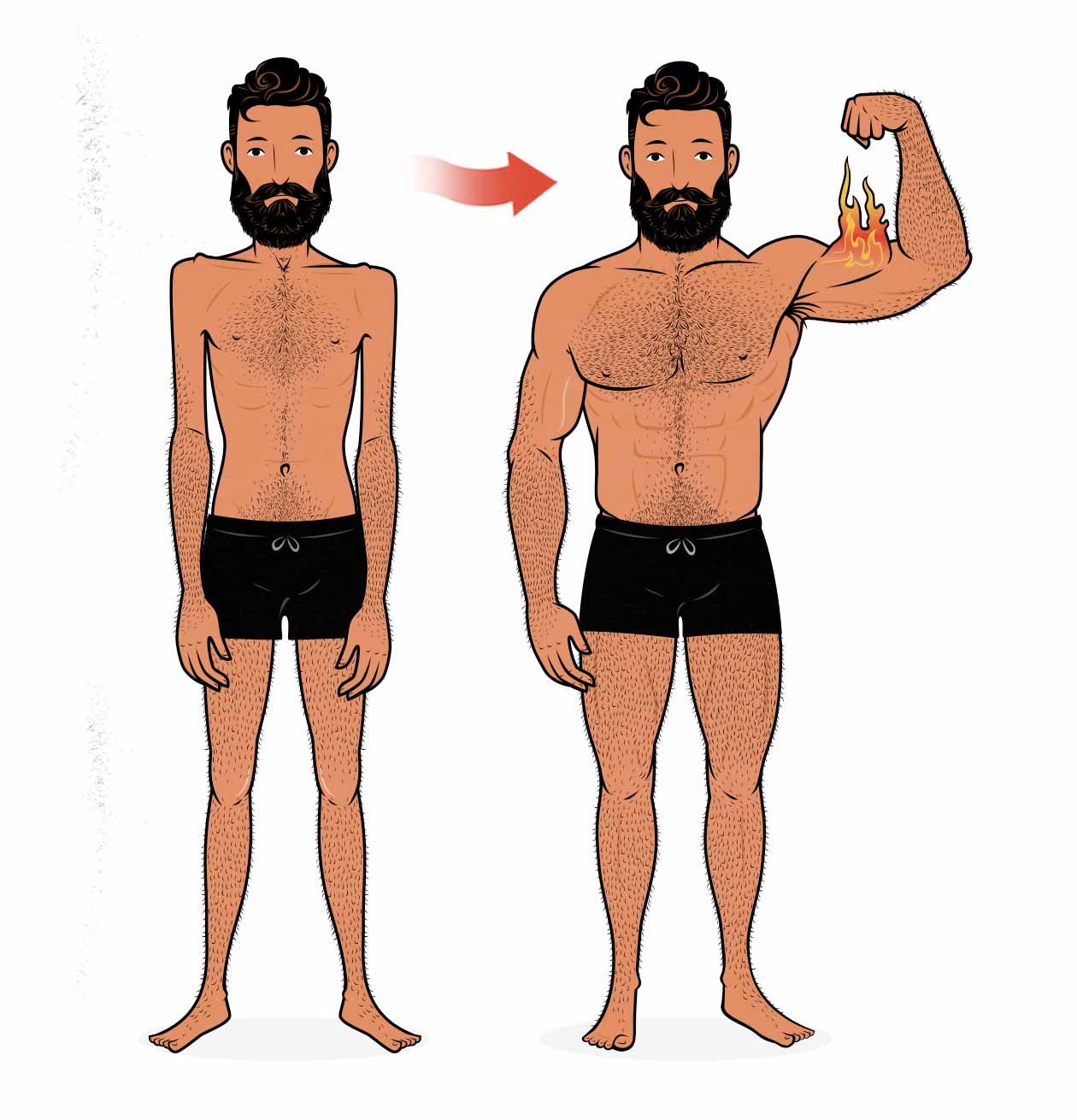
Introduction
Starting Strength is a beginner strength program that’s deeply rooted in powerlifting. Mark Rippetoe, its creator, was a competitive powerlifter for eleven years, and a fairly impressive one, too. At a bodyweight of 220 pounds, he squatted 622 pounds, bench pressed 396, and deadlifted 633 for a total of 1651.
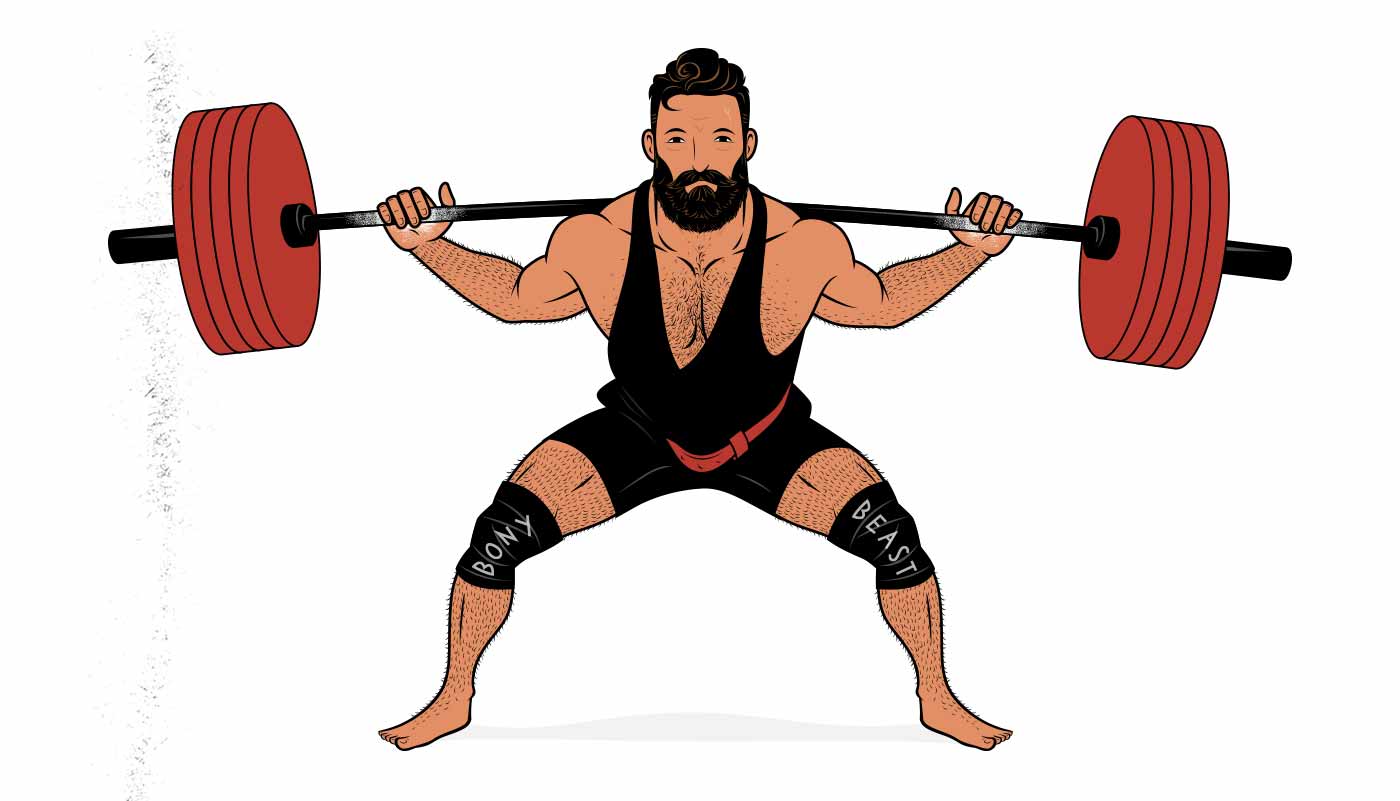
That’s not to say that Starting Strength is a powerlifting program, though. It’s not. In fact, Rippetoe has a number of criticisms of powerlifting. He dislikes how it encourages people to lift with a small range of motion, and he eschews the supportive gear that equipped powerlifters wear—the knee wraps, bench shirts, and squat suits. So Starting Strength isn’t supposed to be used as a beginner powerlifting program, it’s supposed to be an improvement to powerlifting. It’s supposed to be used as an introduction to general strength training.
Starting Strength’s goal is not to train world-class powerlifters. It is, rather, to make normal, average people stronger.
Mark Rippetoe & Matt Reynolds, Starting Strength
One of the things that Rippetoe does throughout the Starting Strength book is to teach us how to get more muscle growth out of the main powerlifting lifts. He recommends low-bar squatting with a narrower stance to a deeper depth, benching with a narrower grip to increase the range of motion, and deadlifting with a conventional stance to increase our back involvement. These changes won’t help people improve their powerlifting total, no, but they certainly make the powerlifting lifts better for stimulating muscle growth. He also favours sets of 5 repetitions instead of using even lower rep ranges, which, again, is quite a bit better for stimulating muscle growth. And he includes the overhead press and power clean alongside the low-bar squat, bench press, and deadlift.
So, is Starting Strength better than a powerlifting program for building muscle? Yes, no doubt. Mind you, most powerlifters alternate between hypertrophy phases, strength phases, and peaking phases. The hypertrophy phases are designed to stimulate muscle growth (size gains), the strength phases are designed to make those bigger muscles stronger (neural gains), and the peaking phases are designed to prepare those big and strong muscles for a powerlifting competition (restful practice).
Strength training isn’t designed to make our muscles bigger. It’s designed to make our big muscles stronger. That means that someone who aspires to become a good powerlifter will typically be advised to start with hypertrophy training to gain muscle size and then switch to strength training as they get closer to their genetic muscular potential. That’s especially true for skinnier people who are starting off with less muscle mass.
Starting Strength most closely resembles the strength training phase of powerlifting training. It’s not designed to stimulate muscle growth. So here’s where things get interesting: what if we compare Starting Strength against a hypertrophy training or bodybuilding program for building muscle? How does it compare then?
The Starting Strength Workouts
Starting Strength has us training three times per week, alternating between two different full-body workouts. This is called a full-body split routine because we train every muscle each workout, but we’re alternating between two distinct workouts.
Workout A
- Low-bar back squat: 3 sets of 5 repetitions (3×5)
- Barbell bench press: 3 sets of 5 repetitions (3×5)
- Conventional deadlift: 1 set of 5 repetitions (1×5)
Workout B
- Low-bar back squat: 3 sets of 5 repetitions (3×5)
- Barbell overhead Press: 3 sets of 5 repetitions (3×5)
- Power Clean: 5 sets of 3 repetitions (5×3)
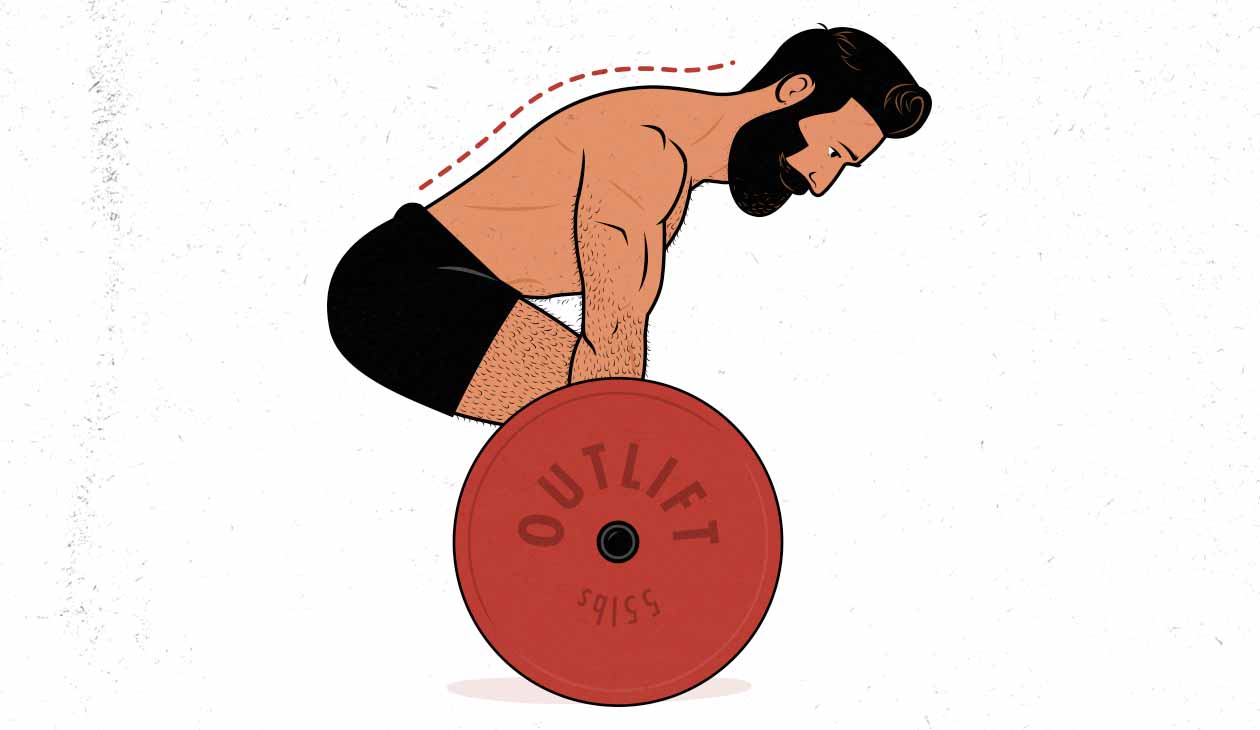
So the main set and rep scheme is doing 3 sets of 5 repetitions. But because deadlifts are disproportionately fatiguing, we do just a single set. And because power training is done in lower rep ranges, the power cleans are done for just 3 reps per set.
Whenever we can complete all three sets with a given weight, we increase the load, adding 5 pounds on the squat, 10 pounds on the deadlift, or 2.5lbs on the upper-body lifts. This is called linear progression, and it works quite well with beginners.
These workouts are simple, elegant, and there’s a strong logic to them. It’s a good minimalist approach to strength training that Mark Rippetoe has refined over many years to make it ideal for the beginners that he’s coached. It’s a really interesting system and there’s a lot to learn from it.
But is it good for gaining muscle size? Let’s see.
Is Starting Strength Good for Building Muscle?
Exercise Selection for Hypertrophy
Mark Rippetoe recommends the following lifts in Starting Strength:
- The Low-Bar Squat (Main Lift)
- The Bench Press
- The Overhead Press
- The Power Clean
- The Conventional Deadlift
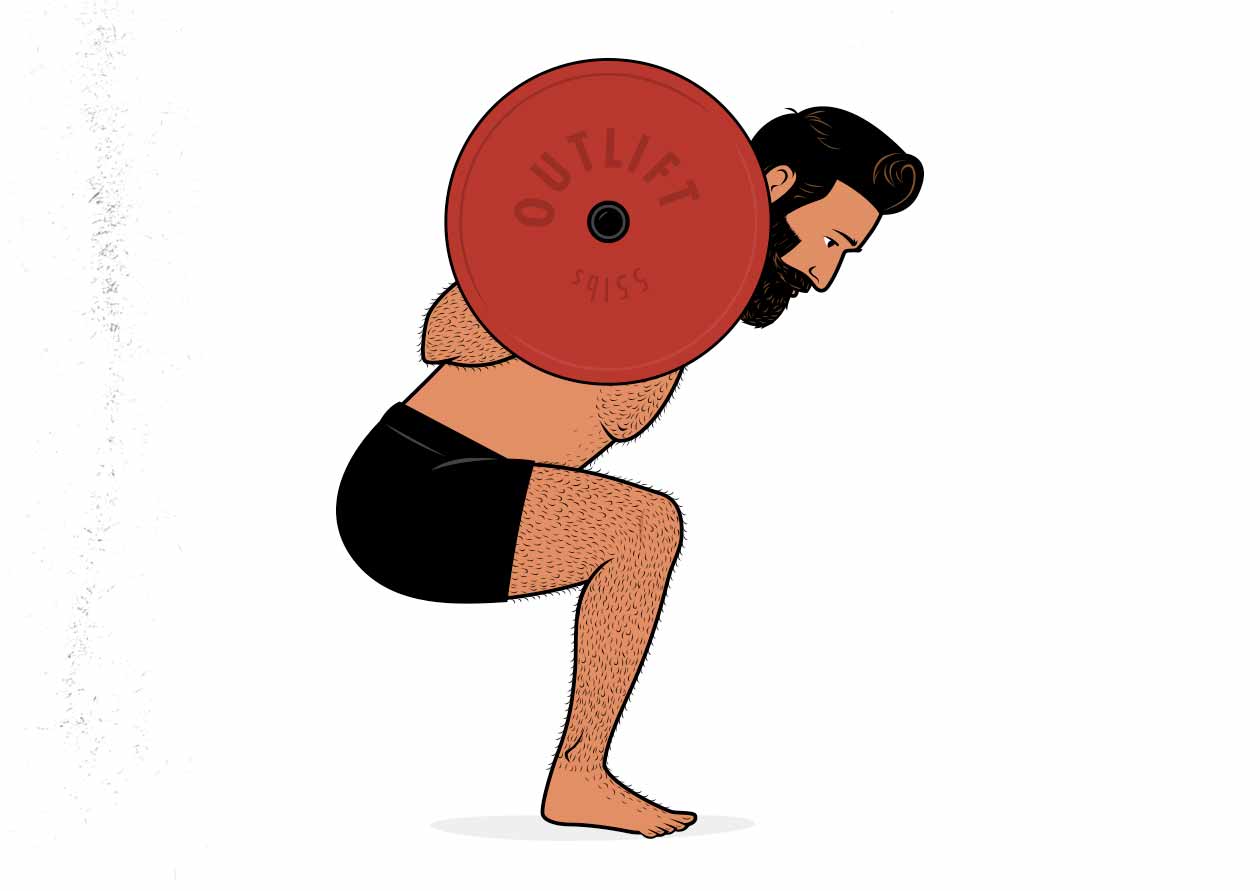
He believes these lifts are the best because they use the most muscle mass, use the greatest effective range of motion, and use the most weight possible (with proper form). And these are great lifts, both for obvious and not-so-obvious reasons. On the obvious side, exactly as Rippetoe states, these are compound lifts that engage a tremendous amount of overall muscle mass through a fairly large range of motion, making them great for stimulating a ton of muscle growth. That’s why this program can be so simple—because these lifts are such an efficient way to build muscle.
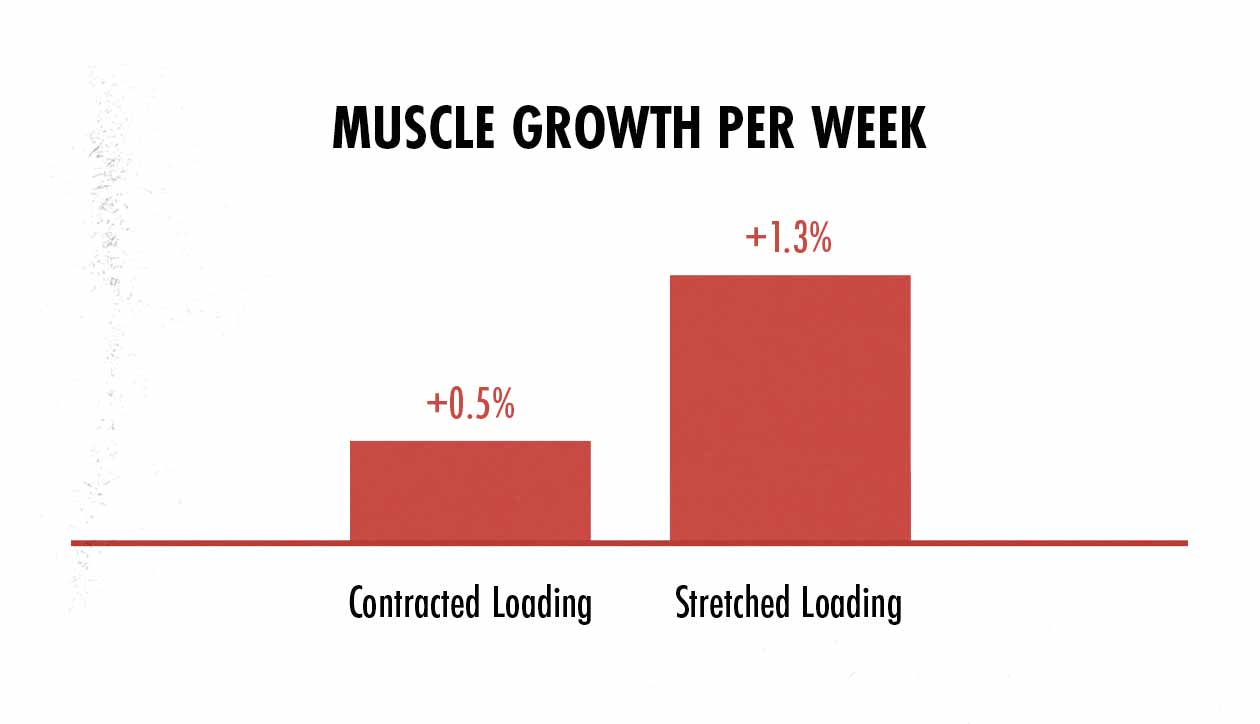
On the not-so-obvious side, these lifts also allow us to challenge our muscles in a deep stretch. Muscle growth is stimulated via mechanical tension, and we can put mechanical tension on our muscles by actively contracting them and by stretching them. When we combine a strong contraction with a deep stretch, the active and passive mechanical tension are added together, stimulating far more muscle growth (study). As a result, the lifts that are hardest while our muscles are stretched tend to be best for building muscle (study).
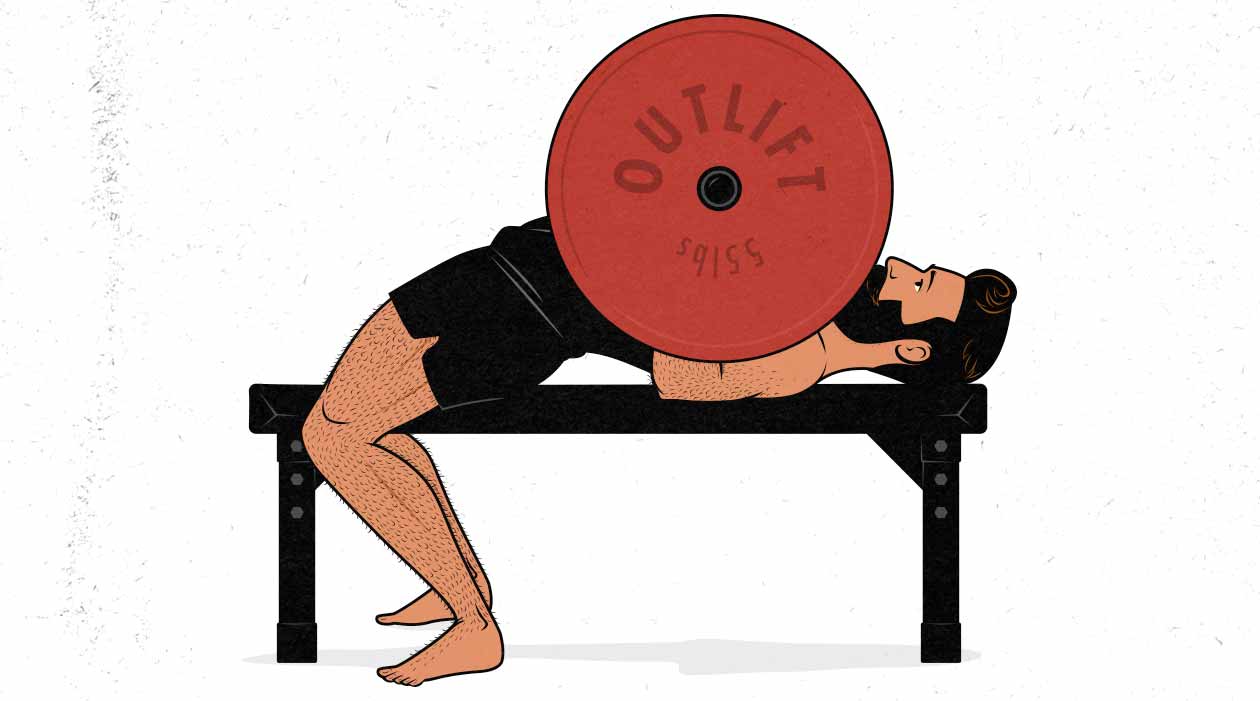
If we consider the bench press, for example, then we get a deep stretch on our chests at the bottom of the lift (when it touches our chests), which is near where the lift is the most challenging (a couple of inches above our chests). As a result, the bottom part of the bench press is amazing for stimulating muscle growth. No real surprise that it’s so popular.
This same benefit applies to the squat, which challenges our quads in a stretched position, and the deadlift, which challenges our hips and hamstrings in stretched positions. Again, this does a good job of explaining their popularity among bodybuilders, powerlifters, and athletes.
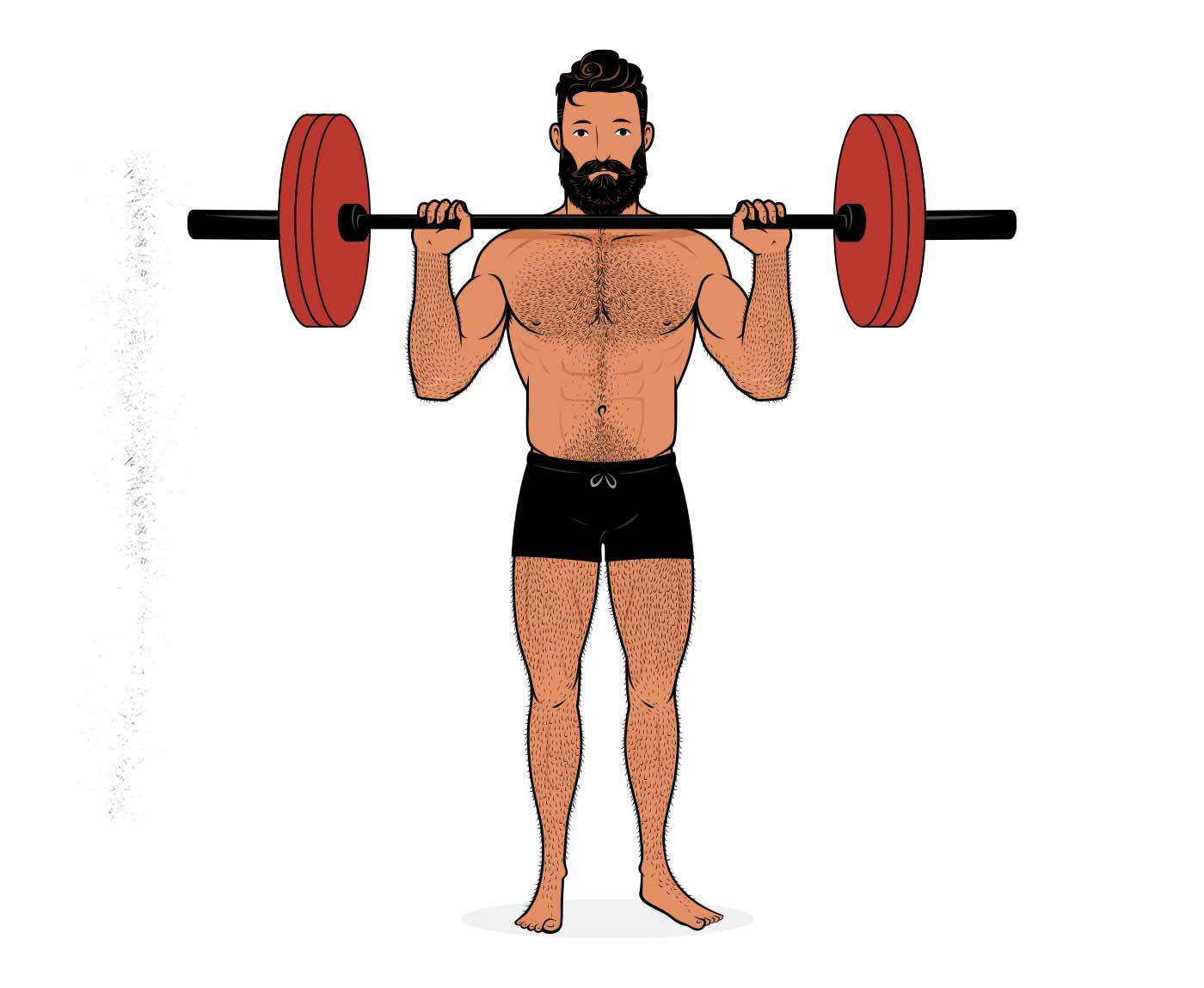
The overhead press doesn’t have this benefit, but it’s a great lift for a number of other reasons: it allows us to train our upper chests and shoulders without our shoulder blades being retracted, and it’s great for our traps. It’s a worthy complement to the bench press, and people often find that their shoulders feel sturdier and stronger when they train both lifts with similar veracity. It’s a worthy addition.
So there’s no doubt that these are some of the very best lifts for building muscle. But even though these lifts are awesome, that doesn’t mean that they’re ideal for beginners or for gaining muscle size. Here’s why:
- There’s no lift for the upper back or biceps. From a powerlifting perspective, that’s not a problem. Powerlifters need backs that are strong enough to deadlift, but not much else. But for gaining overall muscle size, general strength, and aesthetics, it’s important to train our upper backs and biceps with the same vigour as we train our lower bodies. This program is missing the chin-up.
- The power clean is good for turning strength into explosiveness, but it isn’t very good for developing size or strength in the first place. Even for athletes, it usually makes more sense to focus on gaining muscle size first and then down the road, as a more seasoned lifter, to sprinkle in some power training if to improve explosive power. To build more muscle more easily, we can replace the power clean with a lift that’s better for stimulating muscle growth, such as the chin-up.
- There are better squat variations than the low-bar squat for gaining muscle size, general strength, and improving our appearance. The low-bar squat is used in Starting Strength because it better engages the hip and groin muscles and allows for more weight to be lifted. We do this by “sitting back” into the squat and bending at the hips. To squat the weight back up, we flex our hip muscles. There’s nothing inherently wrong with that, but we already have the deadlift and power clean for our hips, so why not use a quad-and-back dominant squat variation? The front squat allows us to lift through an even greater range of motion, especially in the knee joint, while doing an even better job of bulking up our upper backs. It’s also safer, easier on the joints, and easier to recover from. And for beginners, as we’ll cover in a moment, the goblet squat is a very easy squat progression to learn, while still having all of the same benefits as the front squat.
- These lifts aren’t very good for beginners. Unless they’re naturally athletic and/or being coached in person, most skinny beginners will struggle to learn the Big Three powerlifting lifts. They’ll struggle to get to depth while low-bar squatting without crashing into their hips, struggle to bring the barbell down to their chests when benching without their shoulders falling out of position, struggle to do the conventional deadlift without rounding their lower backs, and struggle to press a bar overhead without arching their lower backs. Most egregious of all is the power clean, which is a fairly complex lift to learn, especially for a beginner who doesn’t have an in-person strength coach. That isn’t to say that beginners shouldn’t do these lifts, but it does make it harder to build muscle. The more time we need to spend improving our coordination and technique, the less time we spend stimulating muscle growth. This can slow down our muscle growth for several weeks or months as we struggle to fully engage our muscles with these advanced lifts. For skinny beginners who are eager to start building muscle, that can be frustrating.
- There are no isolation lifts. We’ll give this an entire section. There’s a reason why bodybuilders always include isolation lifts in their routines. And for beginners, there may be an even stronger case for using isolation lifts.
Although the Starting Strength lifts are better versions of the powerlifting lifts for building muscle, they still aren’t ideal or complete. We need a pulling movement for our back and biceps, we don’t need power training, there are better squat variations, and there are better lifts for beginners who want to start building muscle right out of the gate.
No Isolation Movements
Starting Strength has no single-joint “isolation” exercises. That’s a problem. That’s a problem because some muscles only grow properly with single-joint movements. For instance, the long head of the triceps extends our elbows and extends our shoulders. The bench press extends our elbows and flexes our shoulders. If we fully engaged the long head of the triceps fully when benching, we’d be pulling the barbell back to our chests. To solve that problem, we push with the shorter triceps heads instead. That’s why when we measure muscle growth from the bench press, we see that the triceps lag behind (study).
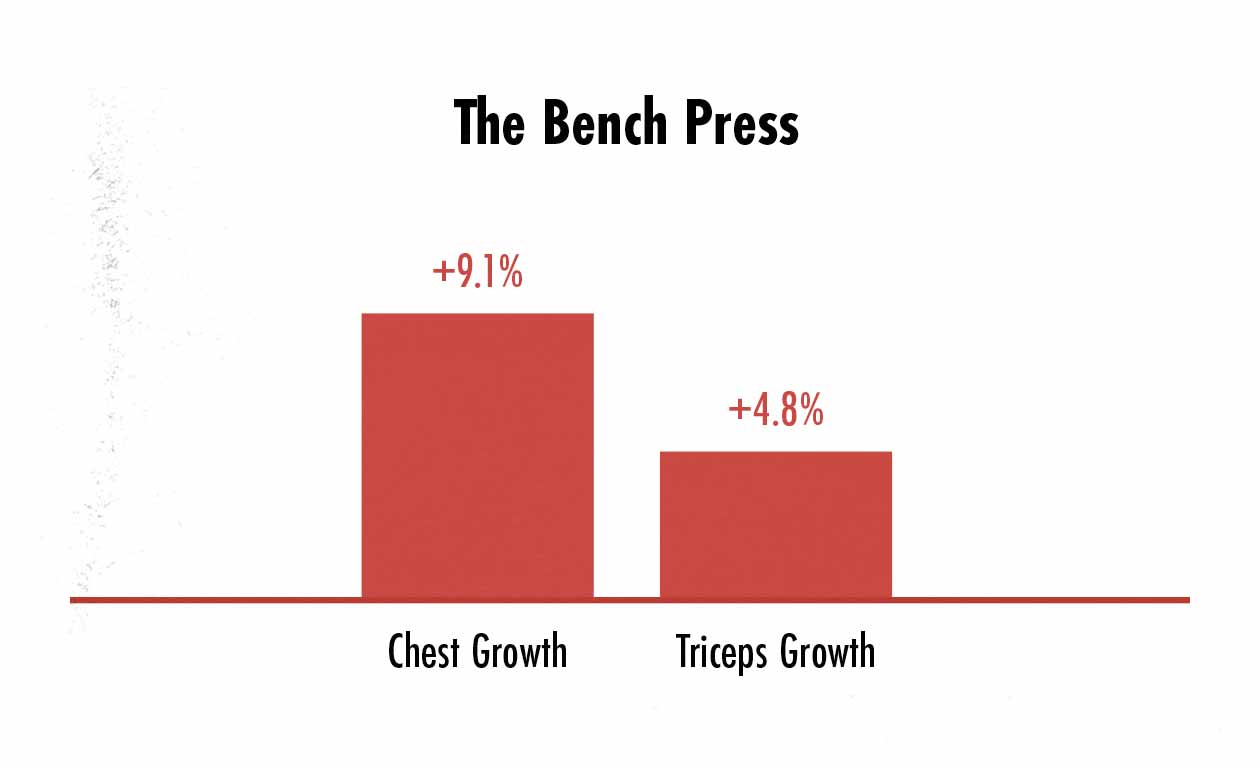
It’s not that our triceps are lagging overall, though; it’s that the long head, in particular, is failing to grow. That’s too bad because it’s a big, strong head that greatly adds to our general strength and arm size. To develop it properly, then, we need something like a skull crusher or overhead extension. When we add those in, we see balanced triceps and chest growth:
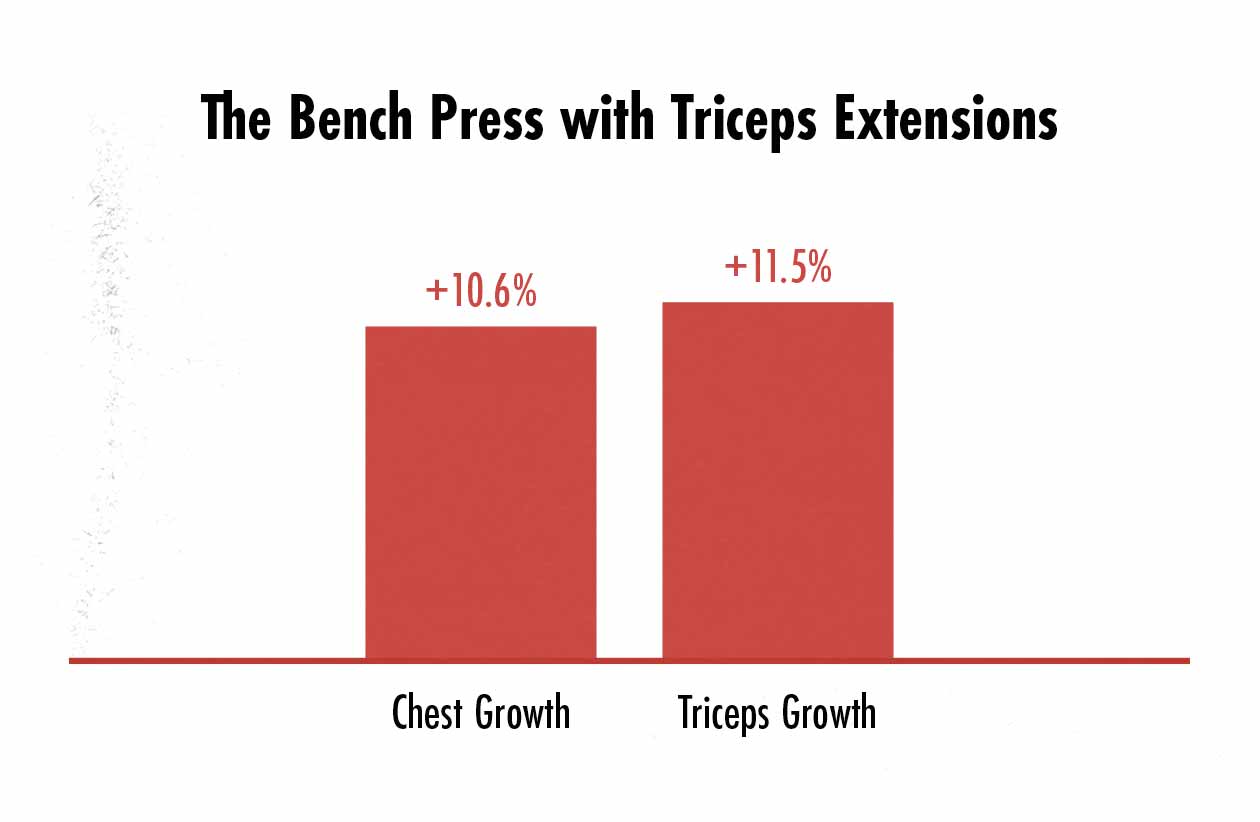
Does that make our workouts a bit longer? Yes. It might add an extra five minutes after we finish our bench pressing. And will it make our workouts more complicated? Absolutely. Our workouts wouldn’t have that same minimalist elegance that Starting Strength has. And will bulking up the long heads of our triceps improve our powerlifting performance? No. But adding in triceps extensions will allow us to gain more muscle size and strength. And it will make our arms grow quite a bit faster.
This is just one example. There are a number of muscles that aren’t trained properly by compound movements. Our shoulders benefit from lateral raises in addition to overhead presses. Our biceps benefit from biceps curls in addition to chin-ups (and Starting Strength doesn’t even have chin-ups, meaning that our biceps aren’t really being worked at all). It would be nice if compound lifts gave us everything we needed, but they don’t.
Now, the next argument is that this program is for beginners. Aren’t the big compound lifts enough for beginners? Can’t we add in all of those isolation lifts later on? We could, yes, but isolation lifts are incredibly valuable to beginners, too. Here’s why:
- Isolation lifts tend to be easier to learn. Simpler lifts are easier to learn, making it easier to forcefully contract our muscles, making it easier to stimulate muscle growth. This allows us to stimulate a robust amount of muscle growth right from our very first workouts.
- Isolation lifts can be performed to failure without much risk of injury, allowing beginners to push themselves to their limits. Beginners often have poorer muscle activation than more seasoned lifters, and so pushing closer to failure tends to yield extra muscle growth (study, study, study, study).
- Isolation lifts aren’t very fatiguing, allowing us to train in higher rep ranges, to use shorter rest times, to push closer to failure, and to accumulate extra training volume, all of which allow us to stimulate extra muscle growth quite easily.
All of this makes isolation lifts an incredibly powerful way for beginners to build muscle faster. By avoiding them early on, we’re just reducing the amount of muscle we build during our first few months of training.
A good bulking routine should be built around the big compound lifts, but isolation lifts should be added for the muscles that aren’t stimulated properly by those bigger lifts. Those isolation lifts are also simpler and safer, making it easier for beginners to stimulate muscle growth right from their very first workout.
Heavy Emphasis on the Squat
The low-bar squat is given a massive emphasis in Starting Strength. Every single workout starts with three sets of squats, giving it twice the training volume of any other lift. Plus, since every workout starts with squats, that’s where our best energy is being invested. By the time we get to our upper-body lifts, we’re already a bit fatigued.
To be fair, there’s wisdom in emphasizing the squat when trying to gain as much muscle mass as possible. Our quads and glutes are by far the biggest muscles in our bodies, and they have incredible potential for growth. The squat is thus the single best lift for adding pounds of muscle to our frames. But even so, most people trying to gain 20 pounds of muscle aren’t hoping to gain 15 of those pounds in their butt and thighs.
Even my wife, who loves the idea of building a stronger lower body, doesn’t want that much emphasis on the hips and thighs. She wants to become stronger overall, and so she’s just as likely to start her workouts with chin-ups, push-ups, or deadlifts.
For men eager to bulk up their upper bodies, the mismatch of goals grows even starker. It can be frustrating to see our squat strength skyrocket while our bench press lags behind, and while our upper back and biceps are barely being worked at all. We can move up several pants sizes while still looking fairly similar in our t-shirts. It’s not that it’s bad to emphasize our lower body so heavily, it’s just that most people want more balanced upper-to-lower-body muscle development and more versatile strength gains. It’s just a mismatch of goals.
It’s not wrong to focus primarily on the squat, but most people aren’t eager to gain most of their muscle size in their hips and thighs, and so a common complaint is that Starting Strength makes people more pear-shaped. That’s not bad, per se, but most people—especially men—want to develop more muscle mass in their upper bodies.
Beginner Variations of the Lifts
Starting Strength is a program that works quite well when people are taught how to do barbell training by an in-person coach. The big barbell lifts aren’t very complicated or dangerous, and so with a bit of coaching, most people can learn how to do them reasonably well during their first few workouts.
The problem is most skinny beginners won’t be training with a personal trainer; they’ll be learning from their friends or following online tutorial videos. There’s nothing wrong with that. That’s how I learned to lift. And again, the barbell lifts aren’t that complicated or dangerous, and there are a lot of great resources online. But when we’re learning the lifts without in-person professional guidance, it can be a huge, massive, enormous help to start with easier progressions.
To make things harder still, skinny beginners tend to have less muscle mass on their frames, longer spines, and lankier limbs. That doesn’t mean that learning the barbell lifts is dangerous, but it can certainly create a frustrating learning curve. In fact, it can take quite a bit of practice before we can do the lifts well enough and heavy enough to stimulate a robust amount of muscle growth in the muscles we’re trying to work. Oftentimes we wind up failing because of our lower back or grip strength, or because our shoulders fall out of position at the bottom of the bench press. A simple solution to this problem is to start with easier progressions.
Many people worry that by starting with easier variations of the big lifts, yes, they might be safer, easier to learn, and foster better long-term lifting techniques and habits… but it might mean missing out on short-term muscle growth. And for a skinny guy who’s desperate to build muscle, that can be disheartening. I remember being skinny. I remember wanting to build muscle as fast as possible. I wasn’t all that eager to spend months doing preparatory progressions. I wanted to start lifting, to start growing.
What’s cool about starting with easier progressions is that they allow us to stimulate more muscle growth when we first start training. If we choose simple brute-strength lifts, then instead of spending weeks improving our coordination on the big compound lifts, we can open the floodgates of muscle growth right from our very first workout.
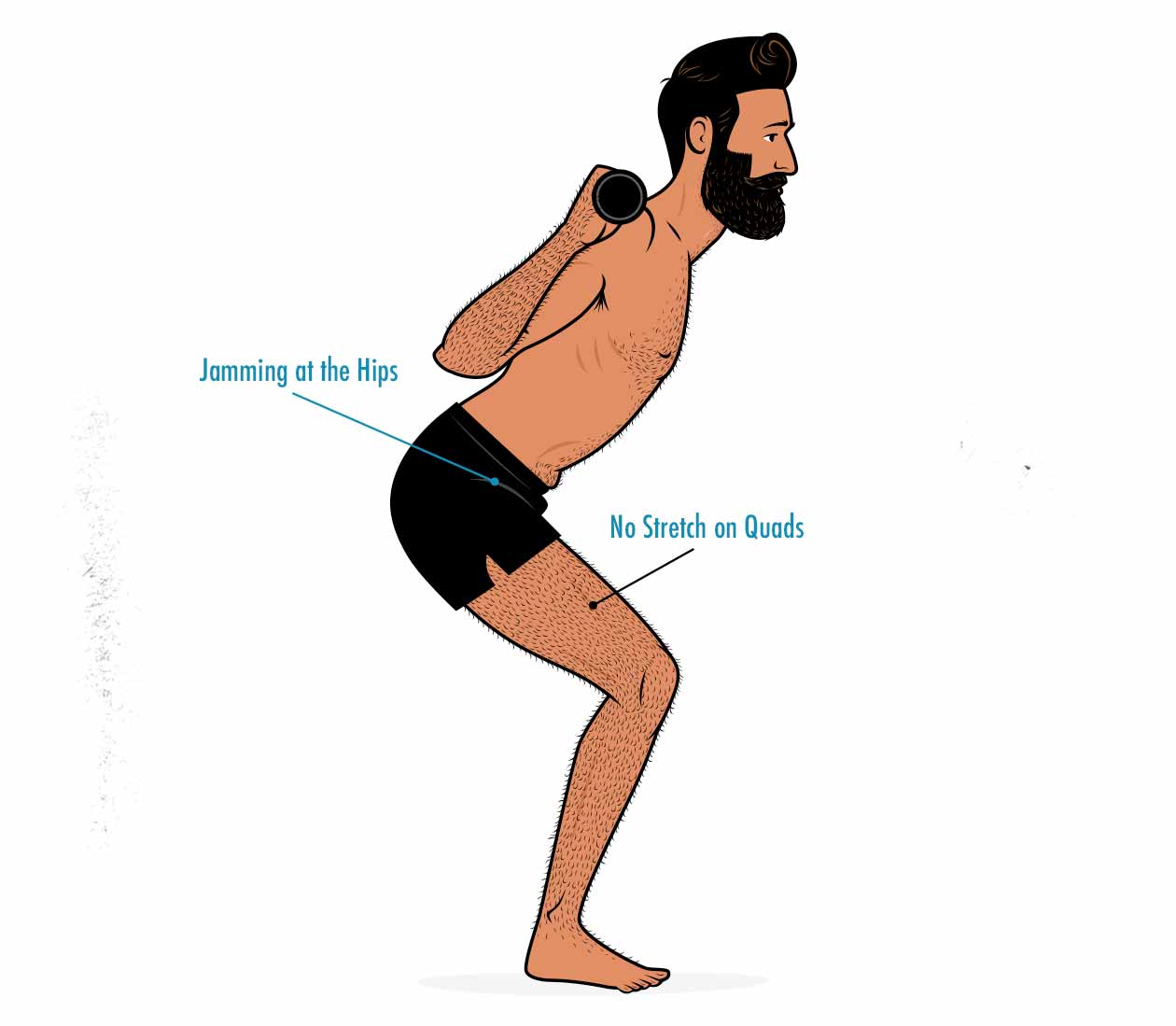
For example, instead of spending weeks trying to learn how to do a low-bar back squat to full depth without rounding or arching our lower backs, we can do a goblet squat.
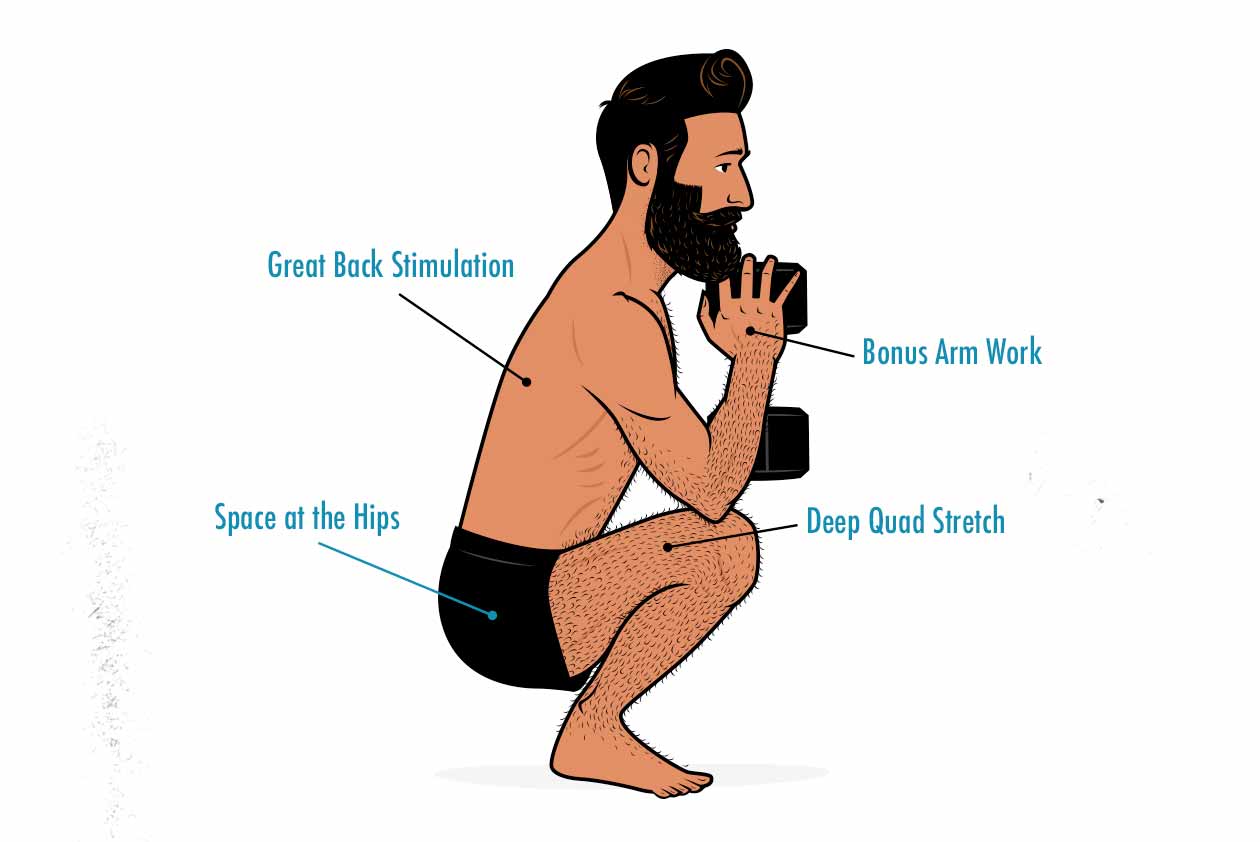
The setup is much easier: all we need to do is grab a dumbbell or weight plate. And holding that weight in front of us keeps our torsos more upright, making it easy to squat to full depth without jamming up at the hips. It also makes it easier to keep our hips in a neutral position while squatting, which sets us up for better squat technique in the future. Because of how much easier it is to learn, most people are able to do a goblet squat with solid technique during their very first workout. Not perfect technique, no, but good enough. Best of all, because the goblet squat is a brute strength lift, it’s easy to push ourselves hard to stimulate muscle growth.
The same is true with the other big lifts. There’s no need to start with a barbell bench press when a dumbbell bench press or push-up is easier to learn and arguably better for stimulating muscle growth (at least for a beginner). And there’s no need to start with conventional deadlifts from the floor when Romanian deadlifts tend to be much easier on our lower backs while still being just as good for improving our grip strength and bulking up our hips and hamstrings.
Same with the overhead press. The fronts of our shoulders are already being worked beautifully by the bench press (or push-up), and the deadlift is already working our traps, so all we need to do is stimulate the sides of our shoulders. That’s where lateral raises can come in handy.
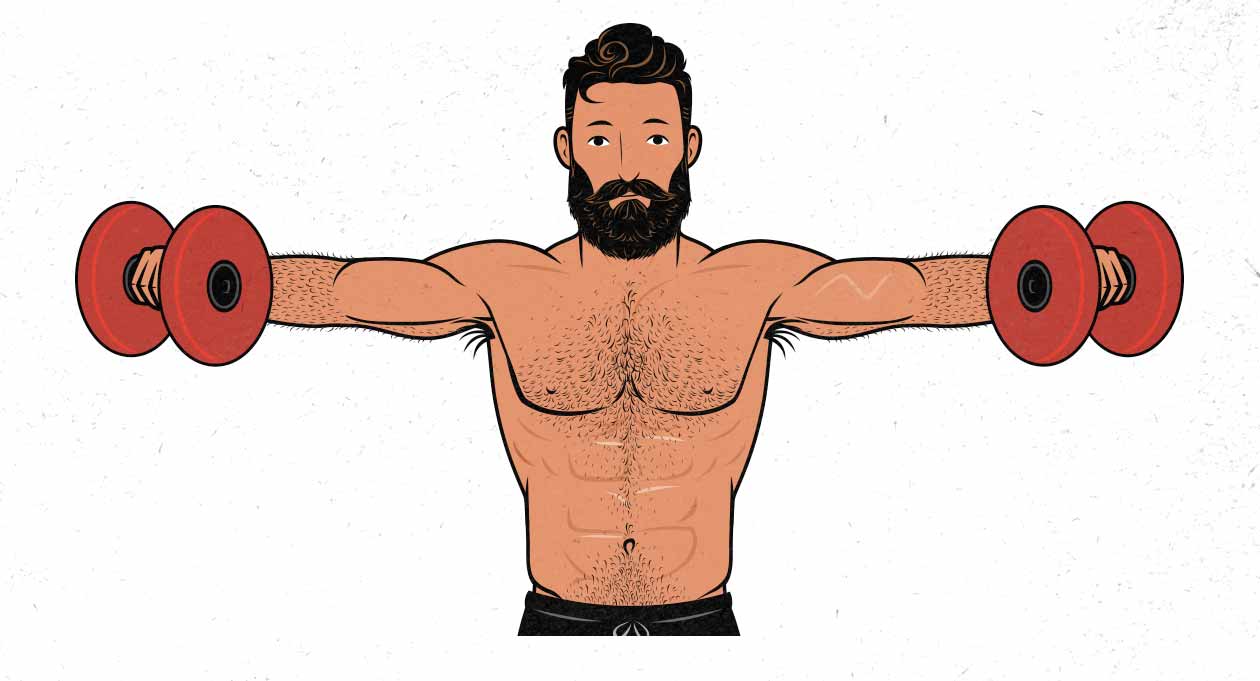
By swapping out some of the more advanced lifts for simpler brute strength lifts, we can shrink the learning curve, speed up muscle growth, reduce the risk of injury, and develop better longterm lifting form. On the other hand, athletic lifters or people training with an in-person coach might not have any problems starting with some of the more advanced lifts. It depends.
Training Frequency for Hypertrophy
Starting Strength is a full-body split that’s done three times per week. Each workout uses slightly different exercises, but we’re training every muscle every workout, and so we’re training our muscles three times per week. That’s perfect for gaining strength and for stimulating muscle growth, especially for beginner and early-intermediate lifters.
A workout stimulates 24–72 hours of muscle growth, meaning that if we want our muscles to be growing steadily all week long, we need to be training them every 2–3 days. That’s why bodybuilder training splits that only train each muscle once per week tend to stimulate less muscle growth than full-body workouts done three times per week.
Now, it’s certainly possible to design a body-part split that has us training 5–6 days per week while training each muscle group 2–3 times per week. But that’s a fairly convoluted way to train, and for beginners, there doesn’t seem to be any real advantage to it. It’s much more efficient to do full-body workouts three times per week. Plus, our hands, our lower backs, and our traps are worked with almost every exercise. And so for beginners who are still sensitive to muscle damage, it can really help to have dedicated recovery days between our workouts.
Finally, Starting Strength also has the advantage of alternating the exercise selection from workout to workout. One workout we do the bench press, the next workout we do the overhead press. One workout we do the deadlift, the next workout we do the power clean. This gives our muscles, joints, and connective tissues a bit of variety. It tends to reduce overall wear and tear, and it also yields more balanced muscle growth.
Starting Strength uses three full-body workouts per week to train every muscle three times per week. That’s a great training frequency for helping a beginner build muscle quickly, efficiently, and safely.
Sets Per Muscle for Hypertrophy
Beginners often don’t need all that many sets per muscle group to stimulate a robust amount of muscle growth. People who are new to lifting weights tend to be quite sensitive to weight training, and so starting with too many sets can cause excessive muscle damage and soreness, increasing our recovery needs and impairing our ability to build muscle.
Starting Strength doesn’t have that problem. This is a true beginner program. There are just 3 sets per exercise and just 3 exercises per workout. In fact, because the deadlift can be disproportionately fatiguing, the training volume is dropped even lower. There’s just a single set. All of this makes total sense, and I think it’s one of the main reasons that Starting Strength is such a successful beginner strength training program.
However, there’s a difference between training for muscle strength versus training for muscle size. When we’re training for strength, we’re trying to improve our ability to recruit motor units and lift forcefully. That requires being fairly fresh. And so using lower training volumes is often ideal. Starting Strength is great for this. We do enough work to stimulate those neurological adaptations, but not so much that we cause too much muscle damage or fatigue.
But when training for muscle growth, a little bit of fatigue is okay, and we don’t always want to take a minimalist approach to our workouts. Yes, it makes sense to start with lower training volumes, but there’s also a benefit to raising that volume from workout to workout. Perhaps the first week starts with just two sets per exercise, then three sets in the second week, and then four sets in the third week. Is that necessary? No. If you’re making progress from week to week, then you’re doing enough. But can gradually increasing our training volume speed up muscle growth? Yes.
When we’re trying to stimulate muscle growth, we usually want to work up to doing 4–8 sets per muscle per workout, and then training our muscles 2–3 times per week. Starting Strength is just 3 sets per muscle, 3 times per week. We’re training our muscles often enough, but there isn’t quite enough work being done every workout to stimulate a maximal amount of muscle growth.
Now, does that mean that we should add extra sets to Starting Strength to stimulate more muscle growth? Probably not. Most beginners doing Starting Strength are already working some muscle groups, such as their lower backs and grips, pretty hard. Plus, low-rep sets tend to be pretty hard on our joints. If we just bumped the training volume higher, we might start to run into recovery issues. That’s one of the reasons why StrongLifts 5×5 is often criticized. Driving the volume higher simply by increasing the number of sets isn’t the proper solution.
So having just 3 sets of 3 exercises per workout isn’t a mistake in the programming. It’s not a bad thing. It’s just that this program is designed to cause strength adaptations more so than hypertrophy adaptations. It’s a beginner strength program, not a beginner size program.
Starting Strength is cleverly programmed to be ideal for a beginner who’s trying to gain 1-rep max strength while gaining a little bit of muscle size. For that goal, it makes sense to do just a few heavy sets each workout. But we’d be able to build muscle faster if we drove that training volume higher.
The Hypertrophy Rep Range
Starting Strength recommends 5 repetitions per set on every lift except for the power clean. There’s nothing inherently wrong with that, especially when someone is trying to focus on improving their 1-rep max strength. In that case, doing 5 reps per set instead of 3–4 reps per set is a nice way to gain some extra muscle growth while gaining strength.
But if we’re trying to build muscle, doing just 5 repetitions per set isn’t a very efficient way of doing that. To understand why that is, we need to consider that we stimulate muscle growth by putting mechanical tension on our muscles. The heavier the weight is, the more tension we put on our muscles with every rep, which is good. The problem is, the heavier the weight is, the fewer reps we can do with it, and so we put less tension on our muscles per set. For example, let’s imagine someone with a 1-rep max of 225 pounds. Here’s a loose estimation of how much we’d expect them to lift in different rep ranges:
- 225 pounds for 1 rep. 225 pounds lifted.
- 200 pounds for 5 reps. 1000 pounds lifted.
- 180 pounds for 8 reps. 1440 pounds lifted.
- 160 pounds for 12 reps. 1920 pounds lifted.
It’s easy to see that lifting in lower rep ranges doesn’t allow us to lift nearly as much weight per set. To make up for that, we’d need to do more overall sets. That’s why you’ll often see programs using 5 sets of 5 repetitions, 4 sets of 8 repetitions, or 3 sets of 12 repetitions. The lower the rep range, the more sets we need to do, at least to a point.
There’s quite a bit of research showing that once we get into a moderate rep ranges, the amount of muscle growth we stimulate per set tends to even out. When comparing low-rep sets (3–5 reps) against moderate-rep sets (8–20 reps), we see that the moderate-rep sets stimulate more muscle growth per set. But when we compare, say, 8-rep sets against 12-rep sets, we don’t see any difference (systematic review). At that point, every set seems to stimulate a similar amount of muscle growth. And that’s why the 8–15 or 6–20 rep range is often called the “hypertrophy rep range.”
Some experts blow the hypertrophy rep range a bit wider than that. Mike Israetel, PhD, argues that the hypertrophy rep range is 5–30 reps per set. Greg Nuckols, MA, believes that the hypertrophy rep range is 4–40 reps per set. But even then, both of them recommend that if we’re trying to build muscle, we should do most of our work in the middle of those rep ranges, not at the lower or higher extremes. For example, Mike Israetel recommends spending 25% of our time lifting in the 5–9 rep range, 50% of our time lifting in the 10–20 rep range, and 25% of our time lifting in the 21–30 rep range.
We also have evidence showing that we can stimulate as much muscle growth with just 3 sets of 12 repetitions as we can with 7 sets of 4 repetitions (study). We don’t know how effective doing 3 sets of 4 repetitions would have been, but we do know that lifting in moderate rep ranges is a reliable way to efficiently stimulate muscle growth, especially when we aren’t doing that many sets per muscle per workout. In Starting Strength, we’re only doing 3 sets per lift, and so we have a better shot at stimulating maximal muscle growth by doing sets of 8+ reps.
The other thing to consider is that lifting heavier weights in lower rep ranges tends to be harder on our joints and connective tissues. That’s another reason why strength training programs tend to use lower volumes than hypertrophy training programs. We need to be more mindful of recovery so that we don’t beat up our joints too much. So again, it’s not that there’s anything wrong with Starting Strength, it’s just that it’s optimized for a different goal.
Starting Strength is a strength training program, and so it uses fairly low-rep sets. Most research shows that we can stimulate more muscle growth per set when lifting in moderate rep ranges. Starting Strength only has 3 sets per lift, combining lower rep ranges with fewer sets. That’s a good approach for gaining 1-rep max strength, but it’s not ideal for gaining muscle size.
Progression & Progressive Overload
Starting Strength is a beginner strength training program that uses linear progression. When we can complete our sets with a given weight, we add more weight to the bar. This is the classic type of progressive overload that’s demonstrated in the parable of Milo of Croton. Milo starts by carrying a small calf, but every day that calf grows heavier, and so his muscles gradually adapt to become stronger over time.
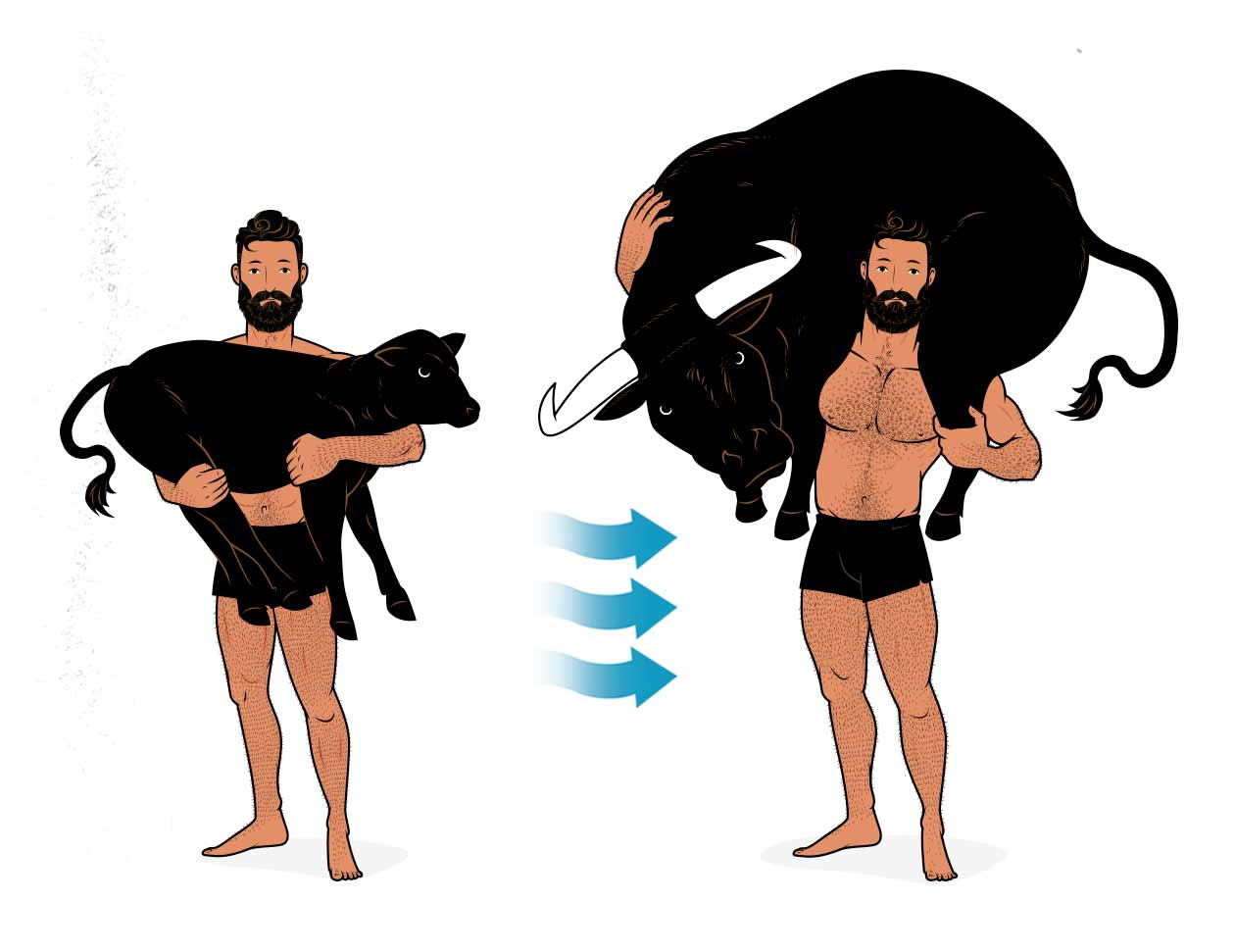
That’s a perfectly valid way of programming progressive overload, especially for beginners and especially when the main goal is improving maximal strength. And since Starting Strength is a strength training program for beginners, that’s absolutely perfect. It’s a simple system that works very well.
However, when we’re lifting weights to gain muscle size, there are a number of different ways that we can program progressive overload. We can add weight, we can add reps, and we can add sets. In fact, adding sets is one of the most reliable ways to progressively overload our muscles. Consider this: when we’re adding weight to the bar, we’re limited by how much stronger we’ve become. If we can only lift 2.5 extra pounds to our 185-pound bench press, that’s 2.5 more pounds for five reps for three sets. That’s 37.5 more pounds lifted. But if we’re also adding an extra set, that’s an extra 187.5 pounds for 5 more repetitions. That’s another 937.5 pounds lifted, in addition to that extra 37.5 pounds.
Now, that doesn’t mean that we always need to be adding extra sets. Oftentimes, linear progression is enough, especially if we’re already doing a hearty amount of sets per muscle. After all, at a certain point, adding more sets can start making our workouts too long, too tiring, or too difficult to recover from. But that isn’t the case with Starting Strength. There aren’t many sets being done here.
The linear progression in Starting Strength is an elegant way to gain strength, and it can work quite well for gaining muscle size, too. But we’re often able to stimulate even more muscle growth when we’re open to adding reps and sets as well.
The “Starting Size” Workouts
Starting Strength was designed to improve upon powerlifting training to make it better for gaining general strength. It’s a good program, and it’s elegant in its minimalism; it’s just that it’s strongly rooted in powerlifting and not designed for building muscle.
So, what if we modify Starting Strength to be better for helping a beginner gain muscle size?

The foundation of Starting Strength is solid. It’s built on big compound lifts, the volume is a reasonable starting point, and alternating between two full-body workouts is an efficient way to stimulate muscle growth. We only need to make a few changes:
- Choose better beginner variations of the big compound lifts, such as swapping low-bar back squats for goblet squats.
- Add in lifts for the muscles that aren’t being stimulated properly, such as a compound pulling movement (such as a chin-up variation) and isolation lifts for our arms (such as biceps curls, triceps extensions, and lateral raises).
- Raise the rep range from 3–5 up to 8–15.
That gives us a workout routine that looks more like this:
Workout A
- Goblet squat: 3 sets of 9 repetitions (3×9)
- Push-up/dumbbell bench press: 3×9
- Row: 3×9
- Biceps curl: 2×11
- Triceps extension: 2×11
- Lateral raise: 2×11
Wokout B
- Chin-up*: 3×max reps
- Push-up/dumbbell bench press: 3×9
- Goblet squat: 3×9
- Romanian deadlift: 3×9
- Plank**: 2 sets
- Side plank**: 2 sets
*Not everyone can do chin-ups right from their very first workout. One solution is to set up a stool under the chin-up bar, start from the top position, hold it for a couple of seconds, and then lower yourself slowly down until you’re at a dead hang. Start with 3–4 lowered reps and gradually add reps over time. The rows and biceps curls will help you develop the strength you need, too. Eventually, you’ll grow strong enough to pull yourself up. Alternatively, you can do lat pulldowns (or at-home lat pulldown alternatives) for 3 sets of 9 repetitions until you’re strong enough to do 3+ chin-ups.
**Planks are great for teaching beginners how to keep a neutral spine while lifting, and they’re a good way to build bigger abs and obliques. But you can swap them out with any isolation lift. For example, if you want to build a thicker neck, you could do neck curls and extensions.
Workout Routine Rationale
These workouts have twice as many lifts, but that doesn’t necessarily make them harder or longer. The lifts are a bit easier to set up, the rep ranges are a bit higher, and the isolation lifts are quick and easy.
If you want to blast through the workouts in less time, though, you can superset the exercises together. You’d do a set of squats, rest 60 seconds, do a set of push-ups, rest another 60 seconds, do your second set of squats, and so on. That way, you’re giving your individual muscles time to regain their strength while doing another lift in the meantime.
The final sets of each exercise can be taken to muscular failure when you feel confident in your technique, especially on isolation lifts. Avoid bringing your lower back to failure, but that shouldn’t be an issue with these lifts. Swap out any lifts that hurt your joints for reasonable alternatives. And add weight whenever you’re able to complete all of your reps in the final set.
Is this a perfectly ideal beginner bulking workout? Not quite. I’d prefer if it were periodized, and I might add a third workout to add more variety to the full-body split. But it’s pretty close, and its minimalist structure makes it easy to include in a short article.
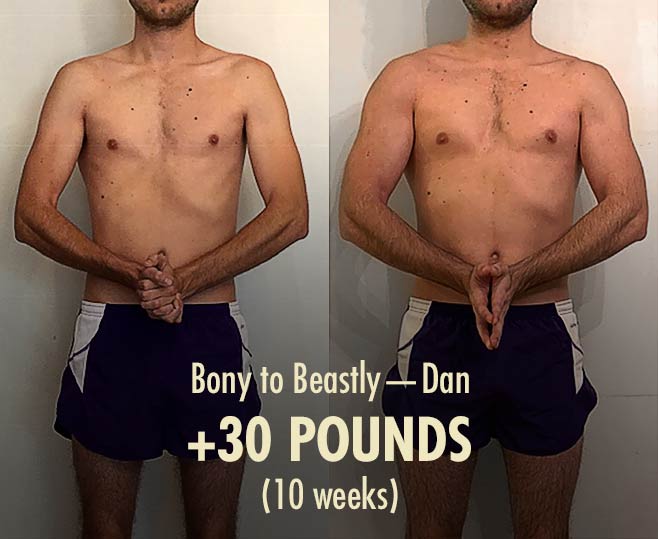
Frequently Asked Questions
Does Starting Strength Increase Size?
Yes, Starting Strength will help people increase their muscle size. However, since the program heavily prioritizes the low-bar back squat, most of those size gains will be in the hips and thighs. That’s why guys will often complaint hat they aren’t building muscle with Starting Strength. It’s not that they aren’t gaining size, it’s just that they aren’t gaining much of that size in their upper bodies.
Is it Better to Build Muscle or Gain Strength?
The best way to increase muscle strength is to increase muscle size, especially if your muscles are currently rather small. So even if your main goal is to get stronger, it often makes more sense to train for muscle size than for muscle strength.
The exception is for powerlifters who are specifically trying to increase their 1-rep max strength on the squat, bench press, and deadlift. In that case, it makes sense to train those specific lifts in the 3–5 rep range to develop maximal strength. But even then, including assistance lifts in moderate rep ranges to build muscle will help increase strength even faster, and with less likelihood of running into a strength plateau.
Does Gaining Strength Increase Muscle Size?
Yes and no. There’s a reason why strength training and hypertrophy training have different names. They aren’t the same thing. Strength training is designed to make our muscles stronger for their size, whereas hypertrophy training is designed to make our muscles bigger and stronger. With that said, most strength training routines will indeed stimulate some muscle growth, just not as efficiently as a hypertrophy training routine would.
How do the two styles of training compare? If we look at a systematic review of all the research, it seems that hypertrophy training stimulates about twice as much muscle growth as strength training per set, and with less fatigue, and with a lower risk of injury.
If you’re training to become bigger and stronger, it’s usually better to do hypertrophy training instead of strength training. Or, at the very least, to include a mix of both styles of training. After all, nothing is forcing us to train for only size or strength. Many of the best workout routines combine both styles of training. Starting Strength, though, is a pure strength training program. There are no moderate-rep sets and no isolation lifts.
What’s the Difference Between StrongLifts and Starting Strength?
The main difference is that Starting Strength has 3 sets of 5 repetitions (3×5) and uses power cleans, whereas StrongLifts has 5 sets of 5 repetitions (5×5) and uses barbell rows. We have a full article on the differences between the two programs here.
Is 5×5 Better than 3×5?
As a general rule of thumb, doing more sets will stimulate more muscle growth, at least up to a point. That’s why 5×5 routines are often considered “better” than 3×5 routines. But for beginners, the opposite can be true. Sometimes it’s better to ease back on the training volume to allow for better recovery between workouts, allowing us to stimulate our muscles more often. That’s why Starting Strength uses fewer sets, and that’s perfectly fine.
A better way for a beginner to stimulate more muscle growth is to increase the number of reps per set, not the number of sets. Instead of doing 3×5 or 5×5, a beginner can get plenty of good volume by doing, for example, 3 sets of 8 reps (3×8).
Summary
Starting Strength is quite good at what it does. It’s a minimalist program that teaches the big powerlifting lifts in a way that’s worse for powerlifting but better for gaining general strength. The book itself is quite good, too, and if you plan on growing old with a barbell, it’s a great read. We don’t agree with everything in it, as we’ve detailed above, but we do recommend it.
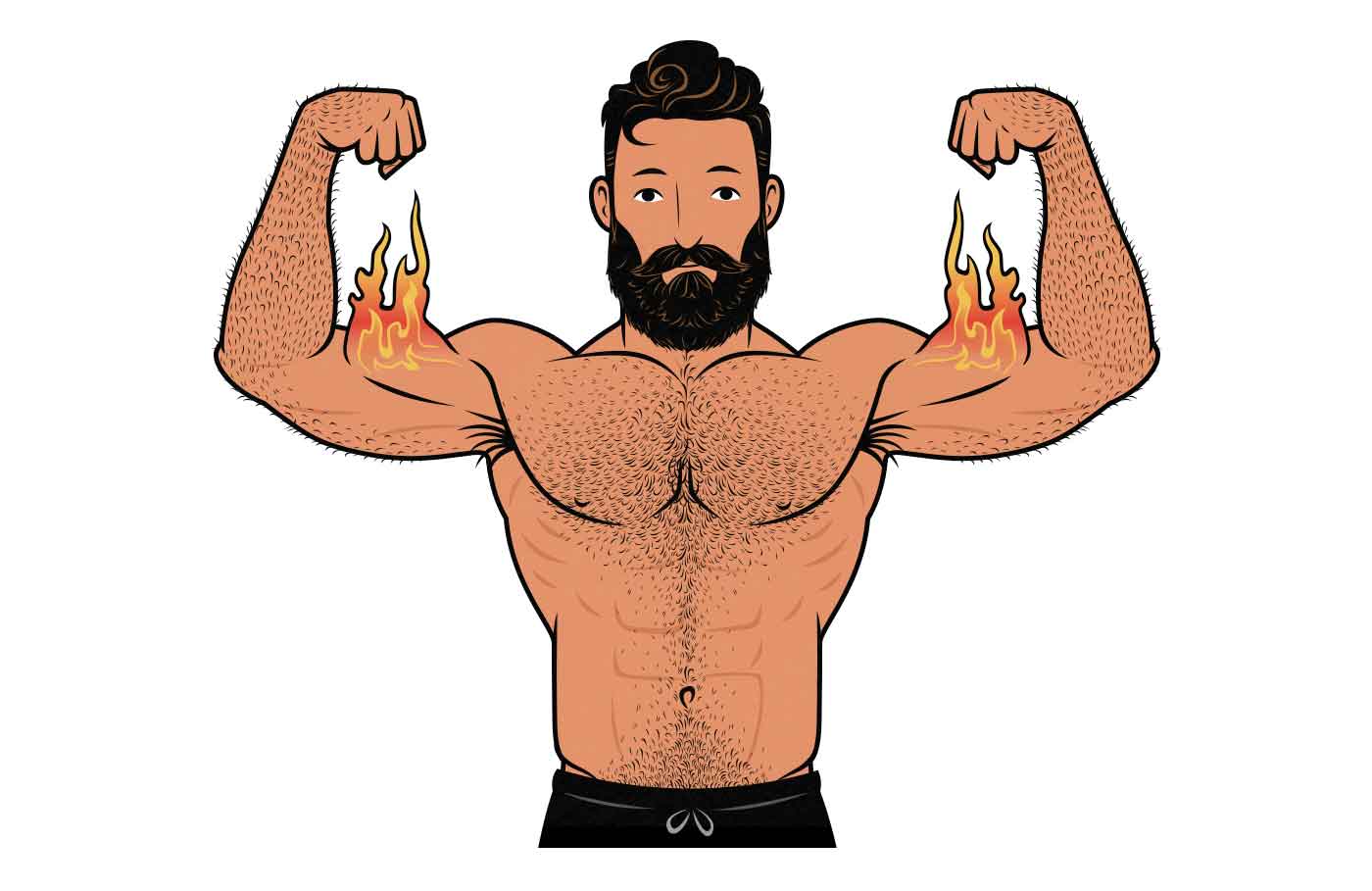
Starting Strength isn’t terrible for gaining muscle size, but most of that muscle mass will be around the hips: in the glutes, hamstrings, adductors, quads, and lower back. That’s great for powerlifting, but it doesn’t line up with most people’s goals, even if their goal is simply to develop well-rounded strength. Plus, we could build muscle even faster (and in a wider variety of muscles) by increasing the rep range, progressing the volume, swapping the power clean for a vertical pulling movement (such as chin-ups), and adding in isolation lifts.
Another problem with Starting Strength is that it starts off with fairly advanced variations of the big barbell lifts. That can work well for athletic lifters who are being coached in person, but for skinny beginners trying to do the program on their own, it creates a big learning curve that needs to be overcome before much muscle growth can be stimulated. It can also ingrain some poor lifting habits which can be a pain to fix down the road. And it may lead to some aches, pains, pulled muscles, or lower-back fatigue. That’s not the end of the world—lifting is quite safe—but it’s not our preferred way of doing it, either.
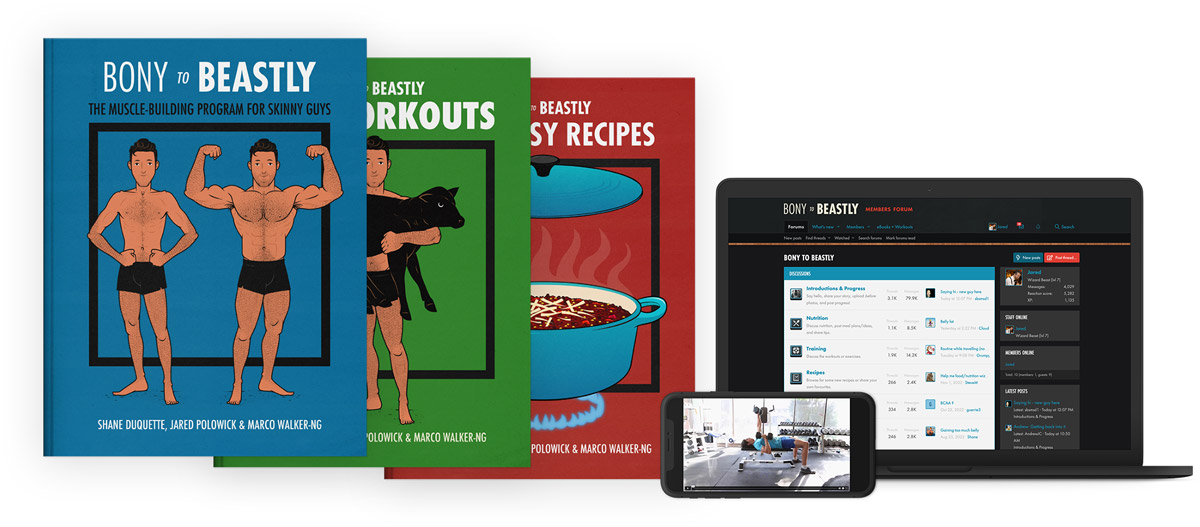
Alright, that’s it for now. If you want more muscle-building information, we have a free muscle-building newsletter. If you want a full exercise, diet, and lifestyle program to help you build muscle and improve your health, check out our Bony to Beastly Program. Or, if you’re already an intermediate lifter, check out our customizable Outlift Hypertrophy Program.




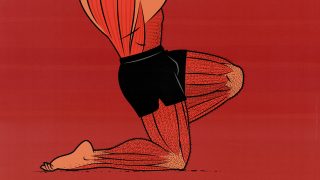
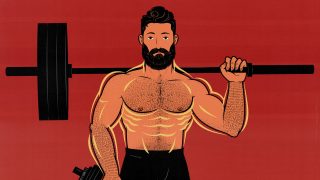
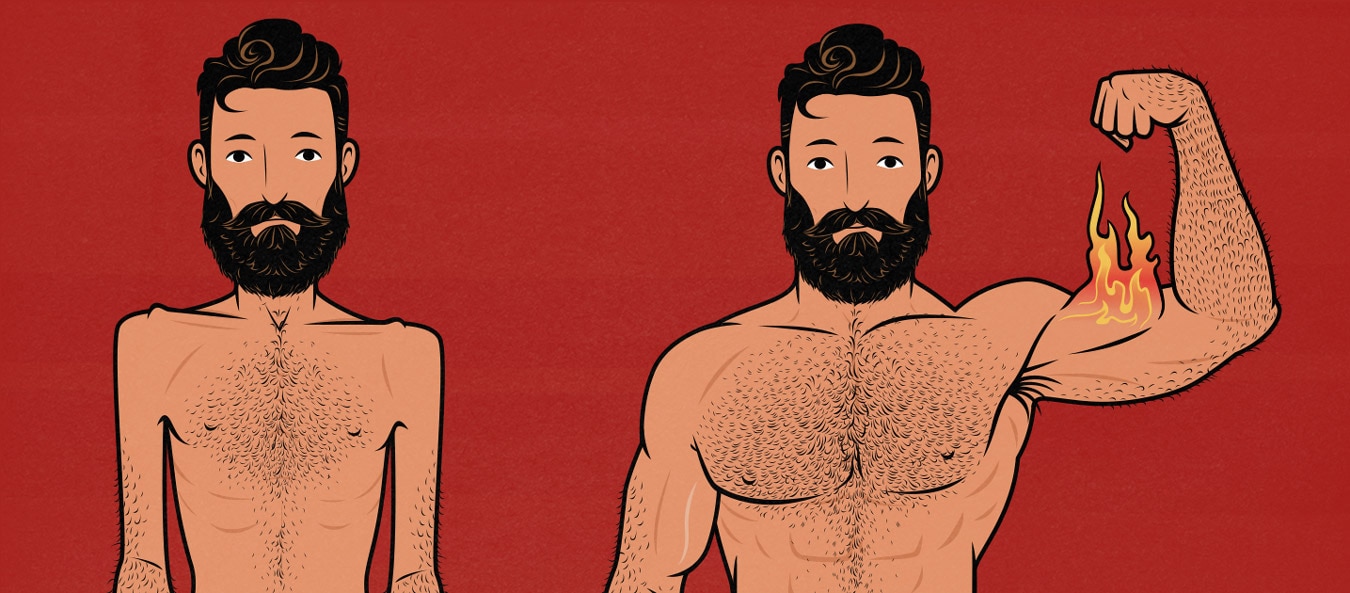
Nice article Shane
I believe that most men want more size and strength in upper bodies so workouts should begin with upper body giants, like, benching, chin-up, overhead press,etc and squats/deadlifts should come later towards end. Upper body workout can not drain/fatigue us so much to interfere with squat/dead, but doing squat/deads first definitely impacts upper body lifts performance. How do you see this?
Secondly if someone can’t do benching due to any reason like lack of bench, lack of spotter if training at home, etc then how do you see replacing bench press with weighted chest-dips on parallel bar? It won’t require spotter or bench, won’t restrict scapular movement unlike benching, and allows fairly large loading like bench. It also works triceps more fully than benching and eliminates leg drives n excessive arches as common in benching.
Hey Farhan, thank you!
If someone wants to prioritize progress on the upper-body lifts, I think it makes sense to put the upper-body lifts first. If I recall correctly, a lot of the classic bodybuilders, such as Steve Reeves, would save the lower-body lifts until nearer to the end of their workouts. Personally, I like to mix it up. Some workouts start with upper-body lifts, some with lower-body lifts. And I often superset them together. For instance, a set of front squats, rest 1–2 minutes, a set of chin-ups, rest 1–2 minutes, and then back to front squats.
If a beginner can’t do the bench press, I’d usually recommend push-ups instead. If someone is doing the barbell bench press without a spotter, I’d recommend using dumbbells or using safety bars. Dips can be a great chest builder, especially if you learn forward while doing it. There’s a large range of motion, it’s a heavy lift, there’s a big stretch on the pecs. The bench press and push-up generally give more balanced chest development, but if you combine dips with the overhead press, you’d be doing pretty good on that front. Totally up to you.
I’m skeptical that the long head of the triceps would be worked well by the dip. There’s movement at the shoulder joint and the arms are behind the body, shortening their length. I think it would have the same issue as the bench press.
I’m not sure that leg drive, arching, and retracted shoulder blades are bad. Leg drive allows us to use heavier weights and engage more muscle mass, arches seem to be quite safe and do a good job of working our spinal erectors, and retracting our shoulder blades makes the bench press quite safe on our shoulders. I like the idea of also having movements that let the shoulder blades roam free, though, such as push-ups and overhead presses. That’s not an argument against the dip, but I do think the bench press is a truly great lift for building muscle.
Thanx for the response. Your suggestion of super setting upper body lifts with Lowe body lifts seems good and it shall be time efficient too.
My pleasure, man. Good luck!
Awesome article like always Shane. I have stubborn calves, probably the worst you’ve ever seen, so I try to hit legs 2x a week but I’m afraid my quads and hamstrings will grow but my calves won’t. Any tips or words of advice?
Hey Sam, thank you!
Your calves will often grow a bit from stabilizing your squats if you let your knees drift forward, as is done with most front squats. However, the stimulation is fairly minor, and so the growth will be minimal and brief. Once you get a decent amount of baseline calf strength, they’ll probably stop growing altogether.
That raises a few questions, I think:
Does it matter if our calves fall behind from a general strength perspective? No, it doesn’t. After all, the reason they’re falling behind is because they aren’t needed for the lifts you’re doing.
Does it matter if your calves fall behind from an aesthetics perspective? Probably not, no. How good we look is mostly based in our upper-body size and perceived “formidability.” If we’re lean and strong with muscular upper bodies, we tend to look better. Our calves don’t really factor into that. On the other hand, you might prefer how you look with bigger calves.
What are your calves for? Mostly for endurance activities, such as walking and jogging, it seems. And so they get a lot of endurance work, have an extreme tolerance for volume, and tend to be quite stubborn to bulk up.
How do we bulk up our calves? To bulk up your calves, the best exercises are ones that load them in a heavy stretch, such as standing calf raises done with a deep stretch at the bottom. Normally you do this by raising your toes up a couple of inches using weight plates or whatnot. And then the trick is to use a lot of volume. They need a lot of volume. So I’d recommend 3+ sets done 3+ times per week. Do that for a few months and your calves should get a bit bigger. Most bodybuilders take the time and effort to go through that process. Most non-bodybuilders don’t.
So to summarize, most people don’t train their calves and don’t care how big their calves are, but if you DO want to bulk up your calves, you need to train them quite hard and quite often. If they aren’t growing, it’s probably because you aren’t doing enough. So do even more.
Hi interesting article. You’re correct that Starting Strength is a beginner programme for getting stronger and as an afterthought get bigger muscles.
Four additional points.
The Power Clean is often dropped by Starting Strength Coaches for more senior and/or out of condition folk due to its nature.
Likewise for older starters they often start with remedial exercises to reach the necessary range of motion and/or strength to do the actual exercises with an empty barbell.
Flexibility is allowed for such folk and sometimes instead of the Bench and Overhead Press the Incline Bench Press is used instead.
Chinups are bought in early as ancillary exercises and where required back extensions.
Thank you for those points, Patrick 🙂
Thanks – great read for someone who has done starting strength for a while and noticed much more leg development than anything else…
One thing Mr Rippetoe would I am sure point out is that the program does recommend swapping in chins – just not from day one. So to be fair there are chin ups.
Hey Martin, thank you!
I see chin-ups listed as a useful assistance exercise, as are triceps extensions and a number of other lifts. And Rippetoe has an entire book on transitioning to the intermediate level. I was just trying to review the default program as recommended in the Starting Strength book (3rd edition).
For me personally, I found I got more growth once I dropped to five rep sets from 8 to 10. Plus the ability to add weight to the bar every session was very satisfying, helping me stay motivated and push harder. This added even more muscle as I kept with the program better and wanted to be in the gym more.
On a more pointed note about starting strength. The program doesn’t add in the power cleans right from the get go any more. You add them a few weeks in when you are no longer able to progress the deadlift as fast. Chins are also added later. You add a chin up once your press stalls. At this point it’s a very well rounded program for making strong healthy individuals. That’s its focus, not vanity.
Hey Tim, thank you for the thoughtful comment.
I don’t think it’s impossible for people to make better progress with lower reps. I’d guess it was something different that made you grow faster when you switched your training style, though. For most people, according to most research, lower reps provides at best the same amount of growth stimulus, not more. But you could be an outlier there. That can happen.
You can add weight to the bar when lifting in more moderate rep ranges, too. I think trying to add weight every workout is a good strategy for beginners, though, no argument there. I like that approach, too. (Although also adding reps and sets only tends to make it better.)
Personal preference is HUGE. If you prefer it, absolutely, yeah, that’s essential. Whatever type of training makes you enjoy training, that’s by far the most important thing for living a long and healthy life 🙂
I agree that Starting Strength veers hard away from vanity, I agree that it’s good for general health, and it’s definitely good for helping beginners get stronger. I think it’s a good beginner strength training program. But I’d just add that hypertrophy training doesn’t need to be about vanity, either. Building muscle is profoundly healthy, traditional hypertrophy training has an incredibly low risk of injury, higher-rep sets work our cardiovascular systems harder, and it comes along with all of the health and general strength advantages of strength training, too. So there’s no reason to think that training for muscle size is less healthy, more vain, or even that it’s worse for general strength. It’s just not as good for developing 1-rep max strength, as a powerlifter would need. But for people who don’t care about powerlifting, I think it’s a better approach for improving general health and strength for most people. And, yeah, it makes us look better, too.
Oh! And thank you for pointing out the power cleans part. I’ll check back with the latest edition and update it 🙂
Hey Tim, I thought you might find this interesting. There’s a new study that just came out that looked at calf training with different rep ranges. What was interesting is that some people saw quite a bit more growth when training in lower rep ranges, whereas other people saw quite a bit more growth when training in higher rep ranges. So it seems that heavier training does work better for some people, whereas light training works better for other people. Makes sense to experiment in different ranges and find what produces the best results at an individual level, I think, with moderate (6–20 reps per set) being an ideal default place to start.
You said:
“the lifts that are hardest while our muscles are stretched tend to be best for building muscle (study).”
Will training these lifts by only/mostly/also holding the weight statically in the stretched position (instead of also/only doing full range of motion) be the ultimate corollary of what you said? I mean, how about doing all-static deadlift/squat/bench press sets in the stretched position?
Thanks.
Hey Fleischman, that’s a good question, but no, lifting through a range of motion tends to stimulate more muscle growth than isometric holds. Ideally, we’d use lifts that are the hardest while our muscles are at long muscle lengths but that also use a fairly large range of motion.
If we combine a large range of motion with a hold at the bottom, though, yeah, maybe that could help. For instance, pausing with the bar on the chest at the bottom of a bench press while maintaining full tension on the chest might stimulate a bit more chest growth per rep, maybe. It’s possible. I don’t know. Some of those lifts are popular in powerlifting training.
For such a detailed review I think you completely miss the point (and perhaps didn’t really read the book?).
It’s recommended to start very light or just with the Barbell. The book prescribes Squats, Rows, bench, OHP and Deadlifts because almost every other exercise is just a variation of these basic and arguably most optimal choices for gains in strength, size and general functionality/athleticism. You master these, get strong in them and then mess around with the fancy variations and fluff work. Why waste time early not learning what’s best?
The book includes Barbell rows, chin ups, Dips, Barbell Curls and lying Tricep extentions which you add over the course of time as you get stronger, can tolerate more volume and the linear progression becomes more challenging. All of which are done at a higher rep range, not just 5s.
Goblet Squats are a great learning tool sure but you’re joking if you think they’re going to add more mass than Barbell squats…
Lastly the book is called “Starting Strength not starting hypertrophy. Need we say anymore.
Hey John, thanks for the comment, man. You’re making some good points. Let me go through them.
I’m not reviewing the program from the perspective of someone looking to learn the barbell lifts and get stronger, with most of that strength being on the squat. I’m reviewing it from the perspective of someone who wants to gain muscle mass by whatever means is best, and to gain some general strength along with it, with that strength being more evenly distributed throughout the body.
It’s fair to ask why I’m reviewing a strength training program from the perspective of someone looking to build muscle. The reason is twofold. First, we have a ton of readers asking us if Starting Strength is good for building muscle. Second, we have a ton of members coming into our programs feeling really frustrated that they spent several months doing Starting Strength, they only gained a noticeable amount of muscle mass in their lower bodies, and they don’t understand why. So this article covers why that can happen.
Is this to say that nobody should do Starting Strength? Of course not. I think it’s a really cool program. If someone wants to spend a couple of months practicing the barbell lifts with weights that are too light to stimulate muscle growth, by all means, they should do it. After those months of practice, they’ll have learned some great skills, and they’ll be able to stimulate quite a lot of growth with those lifts. So it will work out in the end. But a lot of skinny guys are eager to build muscle now. They don’t want to wait months before developing the coordination and working up to weights that are heavy enough to challenge their muscles.
Does Starting Strength recommend eventually adding in some other lifts that are better for hypertrophy? Yeah. But this is a review from the perspective of someone getting started with the program, not someone who does it for a few months and finally gets to add in lifts that, I think, should have been there from the very beginning. And even then, should the squat, bench, and deadlift be done for sets of 5 reps if the goal is to build muscle? Nope, probably not.
Will a goblet squat help someone gain more muscle than a low-bar back squat? That depends. Are we talking about an intermediate lifter or a beginner? If we’re talking about an intermediate lifter, yeah, the low-bar squat is better. But the front squat is even better for building muscle, so I’m not sure why an intermediate lifter would do low-bar squats (unless they’re into powerlifting). And if we’re talking about a beginner, then goblet squats are better, no question. It’s a much simpler movement. Instead of spending months practicing with too-light weights and working on coordination, guys can start building muscle right away. Hell, even for intermediate lifters, goblet squats are amazing for building muscle. They only become poor for building muscle if, a) someone doesn’t have enough upper-body strength to support the dumbbell. But if you’re training your upper body properly right from the get-go, that’s rarely an issue. Or if, b) they get so strong that they can do 12+ reps with the heaviest dumbbell they have access to. That’s rare for beginners and early-intermediate lifters, especially if they’re starting off skinny.
Isolation lifts aren’t fluff work. Especially for beginners. And at the very, very beginning is when beginners benefit from them the very most. After all, that’s when coordination tends to hold beginners back. Using simple brute strength lifts allows them to challenge their muscles right from the get-go, stimulating a great amount of muscle growth right from their very first workout. Plus, it’s a rare beginner who doesn’t want to build bigger biceps. Why wait months before training them?
As for your last point—”the book is called Starting Strength not Starting Hypertrophy”—yes, I agree. That’s my whole point. If someone is interested in hypertrophy, it’s not the best program. That’s the perspective that I’m reviewing it from. Because a lot of people are confused, thinking that Starting Strength is good for bulking up, good for gaining size. It sounds like you realize that it isn’t ideal for building muscle, so I’m not sure we even really disagree.
Let me know if that clears it up. If not, I’m happy to dive deeper 🙂
I think we agree for the most part.
Definitely a few points we would differ on.
Firstly I think the words you are looking for are proportion and balance or perhaps targeted hypertrophy. From a scientific stand point what’s better for hypertrophy/gaining muscle is what adds the most lean tissue to your body not what makes you look more aesthetic. Easiest example here would be front Squats vs back Squats – if you only chose one for adding as much mass as possible you’d choose back, for aesthetic purposes you’d choose front, but in reality you should probably do both.
With regards to Squats I’ve trained multiple clients who haven’t touched a Barbell before who are repping 135 on back Squats comfortably within the first few weeks of training. Most gyms don’t have dumbells that heavy so to challenge their lower body optimally it makes very little sense to programme Goblet Squats unless as an accessory or there are other (mobility?) issues present.
If you don’t like low bar squats just programme high bar, again, more total hypertrophy than Goblet Squats and front Squats. Front Squats are fantastic, especially when alternated with back Squats but they are way more technical and require very good mobility/ strength through thoracic erectors limiting the work your quads and gluteus are doing.
Sets of 5-8 reps have their place in hypertrophy training 100%. Ideally you work through a variety, 5-8, 8 – 12 and 15-20. They all have their place and complement each other.
Id also be interested in what you would define as an intermediate lifter? For me it’s someone who can no longer make consistent linear progression (weekly) and more complex training is required. Usually at the point a male trainee would be repping their bodyweight on Bench and 1.5-2x bodyweight on Squats for multiple sets (provided they’re within a healthy bmi).
Lastly and perhaps most importantly I think encouraging trainees to get comfortable Barbell squatting early is paramount to long term success. The amount of trainees that dodge the Squat rack for 2-3 years and have terrible leg strength and development is tragic. And these trainees will just continue to dodge them generally as they now look the part (on top atleast) and cannot bring themselves to Squat weights that appear to be way too light..
As I said I think we agree for the most part.
We’re kind of arguing nuances (which I enjoy!). If someone came to me and wanted to do 5-rep sets of low-bar squats instead of 7-rep sets of front squats, I’d tell them to go for it. Both variations are sweet. It’s just that if someone came to me wanting to bulk up, I’d default to the front squat for moderate reps. Maybe the opposite for you. But that’s a fairly minor difference.
And I hear you on the value of squatting. We start people squatting 2–3x per week right from the beginning. I don’t think it matters if people use a dumbbell or a barbell, although at some point progressing to the barbell is an important part of continuing to get stronger. I don’t particularly mind if people have proportionally weaker legs, but if we’re talking about ideals, yeah, I think it’s sweet to build a physique that’s strong overall 🙂
And you make a good point about squats being perhaps the single best lift for adding overall muscle mass. Most guys aren’t super keen on gaining 20 pounds only to realize that 15 of those pounds are in their thighs and hips. But you’re right, squats are still amazing for hypertrophy, just somewhat irrelevant to aesthetics.
I’m not sure I agree that low-bar squats are better than front squats for overall hypertrophy (or general strength, for that matter). For the quads, front squats allow us to go deeper, the knees bend quite a lot more, and we get a much better stretch on the quads. Pretty much all research shows that with squads, it’s better to stretch the quads deeper, even if that means using lighter weights. For similar reasons, you could argue that the low-bar squat is better for the hips—the second biggest muscle in our bodies. We get a much deeper hip angle, challenging our glutes in a greater stretch, and with much longer moment arms. Both lifts are great for both, though.
The front squat has some other advantages, too: it’s easier on the joints, less fatiguing, safer, it’s great for improving posture, and it’s sweet for building a thicker torso. I’d say that makes it the better hypertrophy lift, and arguably the better lift for developing general strength, whereas the low-bar squat is better for the sport of powerlifting.
We don’t need to use just one lift to stimulate hypertrophy. Combine front squats with Romanian deadlifts and you’ve got the best of both worlds. We’ve got one lift going maximally deep at the knees and another going maximally deep at the hips. And because Romanian deadlifts don’t have (much) bend at the knees, we get the hamstrings fully stretched and working hard enough to stimulate muscle growth, too.
High-bar squats are great, yeah. No argument from me there. I still think front squats are slightly better, but we give the option for high-bar, too (and a few other varieties, including low-bar).
Goblet squats are way deeper than low-bar back squats and are typically done in higher rep ranges. Someone low-bar squatting 225 pounds for 5 reps will probably be hard pressed to goblet squat 100 pounds for 10 reps. And that 100-pound goblet squat will stimulate more muscle growth per set and per unit of fatigue.
I often say that sets of 6–20 reps are ideal for building muscle, different lifts work better in different rep ranges, and using a mix is best. And we go outside of that range sometimes. We just do most of our training there. You’re saying 5–20, and that’s fine, too. I think we agree here.
I think there are a few different ways to define an intermediate lifter. Your definition works. I’d also say that someone doing front squats, bench presses, deadlifts, overhead presses, and chin-ups with great technique is an intermediate lifter from a technique standpoint. And from a hypertrophy perspective, someone who’s already gotten their newbie gains and is dealing with slower rates of muscle growth could be called an intermediate even if they’re still making weekly linear progress on some lifts.
Ok, this is the best article so far and I love it.
I would really like it if you wrote some motivational articles.Because people won’t stop dragging us down. I have been listening to lots of shit like, “Hey you; it’s been a month and no change. Just quit bro!”
Even when I barely mention working out they will be like, “Why would you go? You will break your bones!” *Laughter*
I am so pissed off by those kinds of comments. So please give us something to motivate us?
Thanks!
Motivation isn’t really my area of expertise. I mean, we try to be motivating and positive, but I’m not sure I’d be the best person to write motivation articles. With that said, what you’re hearing is definitely bogus. If it’s been a month without change, that doesn’t mean you should give up, it means you should strategically adjust.
For example, if a week goes by and you don’t gain weight, it doesn’t mean you should stop trying to gain weight, it just means you weren’t in a calorie surplus, and so you need to add some extra calories into your diet. Maybe 200–300 calories. Weight yourself again a week later, and again, adjust as needed. That’s how we turn a lack of results into steady, consistent progress 🙂
You won’t break your bones. That’s not really a lifting injury. If you hurt yourself lifting, it’ll probably be a weight plate falling your toe, a pulled muscle, a bruise on your shin from walking into something, or a strained neck. So don’t stress too much about that. But nonetheless, still best to be careful.
I hope that helps. And you’ll get there. Just keep adjusting whenever you hit a setback. You’ll get there 🙂
ok Tnx for that..that was help full
i was thinking abt my injury abt 4years ago,i broke my hand and got a surgery the dr.s told me its healed now,its fixed but since i have started working out deadlift is one of the scariest workout in my programm fearing that it wud break it again(in the same place cuz its dragging my hand down and its very heavy)
so what shud i do …do i need to keep workn or wud recommend me some workout that are very effective as dead lift?
tnx
The reason why a beginner learns squats and not goblet squats is for that very reason: squats are more difficult.
If a beginner spends 3 months goblet squatting, that is 3 months lost learning how to squat. Your article is quite well thought out and seems quite academic; however most is redundant. Just writing for writing sake. A waste of time.
And barbell rows can be substituted for power cleans; therefore upper back can be stimulated.
Pull ups can be added to the end of a workout for biceps and so can dips for triceps.
The idea is to gain most of your muscle “90%” with these lifts without the complication.
After 2 to 3 years when you’re maxing out on your genetic potential, analyze weak points, cut down on the compound lifts, and add in some isolation lifts to round off your physique.
No need to write a “novel” and complicate things.
Alright, so this evidently wasn’t your thing, and that’s cool.
If a beginner spends 3 months goblet squatting, they’re learning how to squat. They are squatting. And if the goal is building muscle, it’s hardly a waste of time. It’s a great way to build a ton of muscle. Now, are they learning how to do a low-bar squat? No. But who cares? A powerlifter might care, but why should anyone else? I’m not even sure a non-powerlifter would ever benefit from learning that specific low-bar variation (although there’s nothing wrong with doing so, either).
If you swap the power cleans for barbell rows, you’re changing the program against Rippetoe’s advice, though, right? Doesn’t he explicitly say not to do that? But, yes, you could change the program to make it better for building muscle. That’s my whole point.
Beginners gain a huge advantage from doing isolation lifts. It cuts down the learning curve, allowing them to build muscle more quickly. Why not get 90% of the way to your genetic potential in far less time, right? Why go the slow way? And why intentionally let your arms lag behind? What’s the advantage of that? I mean, if you don’t care, that’s cool. Nothing wrong with skipping curls. But if you want bigger arms, no reason not to curl from day one. You’ll build bigger arms much faster.
I’m not really sure what you’re saying, dude.
Your argument that using 1) isolation movements 2) with less weights and 3) a shorter range of motion (albeit with the exception of your goblet squat/front squat having more ROM) will somehow build muscle much faster than using compound exercises that 1) recruit the most muscle mass, 2) over the longest effective range of motion, And 3) allowing the most weight to be lifted, doesn’t really add up.
If our hypothetical new guy starts “hypertrophy” training with 3×8 or 4×12 squats, and we all know he can’t even do 135lbs for the prescribed reps, but for the sake of argument let’s say he can do 4x12x135 lbs, how much can he add to his hypertrophy reps and sets in the next 6 months? 4x12x225? 250lbs perhaps? How much Hypertrophy has he stimulated?
Now say knew “guy#2” comes in, and we’ll give him the same 3 x5 x135 lbs squat. And over the next six months, guy#2 takes that squat to 3x5x405lbs following a Novice linear progression (Starting Strength). How much mass vs strength did he stimulate?
How did Guy#2’s body tell the difference between a “strength” and a”hypertrophy” stimulus? How does the body know guy#2 wants to get strong only and guy#1 wants to get big only?
And when after 3-6months NLP guy#2 says to himself, “you know what, guy#2, we should focus on some Hypertrophy. I want to be a bit bigger in certain areas.” How much more hypertrophy can guy#2’s 405 squat stimulate when he switches to a higher rep, higher volume program vs guy#1’s 250lbs squat?
What happens when we do the same with Bench vs DB bench over the same course of time. Or the conventional Deadlift vs the Romanian deadlift? Which lifts are really stimulating more growth?
Barbell movements aren’t overly hard to learn, bend over, stand up, don’t fall over, add weight.
Chin-ups stimulate bicep growth just like dips stimulate tricep growth, while still satisfying the 3 criteria, no? So add em in. You wanna curl? Ok, do your squats and presses first. “If you don’t eat your meat you can’t have any pudding.”
But know what’s more important. The big 4 core lifts will stimulate more size AND strength than any amount of reps and sets using lighter weight and less muscle mass.
Thoughts?
Hey Myles, let me do my best to respond to all of this.
1) Isolation lifts. The argument is that compound lifts are better than isolation lifts for stimulating overall muscle growth, but that we can build muscle even faster by adding in certain isolation lifts.
2) Heaviness. With isolation lifts, we’re still choosing weights that bring our muscles within 0–2 reps of failure. That provides the perfect muscle growth stimulus to the muscles being challenged, same as with compound lifts. The absolute amount of weight being lifted isn’t everything. Consider the deadlift vs the bench press. The deadlift is much heavier, but the bench press still does a better job of stimulating the chest. The same is true with isolation lifts. The barbell row is heavier than the barbell curl, but the curl does a great job of stimulating our biceps.
3) Range of motion. Using a larger effective range of motion is usually a good thing, yeah. Note that compound lifts aren’t always great for that, though. Consider the row. As we pull our elbows back, we lengthen the biceps, reducing their range of motion. Same thing with a chin-up. That’s why the curl is a valuable addition. It uses a longer effective range of motion for the biceps. The same problem arises for the triceps with the bench press and dips. That’s why triceps extensions are so valuable for building bigger triceps.
Plus, it’s not quite as simple as a larger range of motion being better. Getting a full contraction doesn’t seem to matter very much, whereas getting a deep stretch is a great way to improve muscle stimulation. That’s why lifts like Romanian deadlifts are so good for the hips and hamstrings, squats are so good for the quads, and bench presses are so good for the chest, and chin-ups are so good for the lats.
Compound Guy vs Compound+Isolation Guy: we have quite a lot of research showing that doing both compound and isolation lifts is better for building muscle, so we’d expect the guy doing squats + isolation lifts to build more muscle. But it depends.
For example, in this study, the researchers compared the muscle development of people doing just squats with people doing squats, leg presses and leg extensions. The volume was equated, so both groups did the same amount of leg work overall, and both saw a similar amount of overall muscle growth. But the group doing isolation lifts got more balanced quad growth.
That’s not quite what we’re recommending, though. What we’re recommending is using a foundation of compound lifts, then using certain isolation lifts to fill in the gaps. The squat already does a great job of working the quads and glutes, so there’s no real need to add in leg presses and leg extensions. It can help, but it’s not that important. And in my own training, I basically only squat.
Where the squat falters is with its ability to work the hamstrings. The Romanian deadlift is great for that, so there’s no problem.
Where Starting Strength is lacking, though, is with some of its upper-body work. There are no lifts that do a good job of working the biceps or triceps, which is why I recommend including biceps curls and triceps extensions. Nothing for the neck, so people who want growth there should add some neck curls and extensions. And even the lats could do with a lift that works them through a larger effective range of motion—the chin-up.
Does the deadlift or Romanian deadlift stimulate more growth? It depends on what you’re trying to do. The Romanian deadlift tends to be easier for beginners, easier on the lower back. For a beginner, I’d argue that it stimulates more muscle growth. But for intermediate lifters, the conventional deadlift tends to stimulate more overall muscle growth because it works the back harder, whereas the Romanian deadlift is better for the hamstrings because it works them through a deeper range of motion.
Are barbell lifts hard to learn? Some people are naturally athletic and master the barbell lifts quite quickly, especially when working with an in-person coach. Other people don’t. They struggle to squat to depth, struggle to keep their spines in a neutral position while deadlifting, and struggle with shoulder positioning while benching. With that said, I agree with you overall. Learning the barbell lifts is much easier than, say, mastering a sport. With a couple of months of smart practice, most people can learn to lift with great technique.
How does the body know the difference between different training stimuli? When we train in lower rep ranges, our bodies adapt by learning to contract more of our muscle fibres simultaneously, increasing our maximal strength. When we train in higher rep ranges, our bodies adapt by storing more fuel in our muscles, increasing our anaerobic muscular endurance. And when we train in VERY high rep ranges, our bodies adapt by improving our aerobic fitness. With that said, there’s tons of overlap. Doing a 3-rep set of squats is often enough to challenge our cardiovascular systems. And people biking long distances often do a great job of gaining size and strength in their quads.
But if the goal is to get stronger for your size, best to focus on lower rep ranges (3–5, usually). If your goal is to get bigger and stronger, focus on moderate rep ranges (6–20, usually). And if you want more muscular endurance, focus on higher rep ranges (20+).
Are chin-ups and dips great for the biceps and triceps? You can gain some muscle size in your biceps and triceps by doing chin-ups and dips, but keep in mind that the range of motion is really short on those muscles. The triceps are shortened when you move your elbows back, the biceps shortened when you move your elbows up. So, no, they don’t satisfy those three criteria. Perhaps more importantly, the arm muscles can’t fully contract without interfering with the lifts. That’s why they don’t tend to be great lifts for the arms.
Are the Big 4 core lifts the most important lifts for building muscle? Yeah, the big compound lifts are the best for building muscle overall. I’m not sure which 4 lifts you mean, but the 5 lifts in Starting Strength (low-bar squat, bench, deadlift, press, and row) are fantastic.
We think the front squat, bench press, deadlift, press, and chin-up are an even better set of default foundational lifts, as explained here, but that’s admittedly a fairly small difference. The most important thing is getting stronger at the big lifts, whichever variations of those lifts you choose 🙂
Chin-ups are part of the program. The program has 3 phases with A&B workouts
Phase 1
Workout A: Squat/Overhead Press/Deadlift
Workout B: Squat/Bench Press/Deadlift
Phase 2
Workout A: Squat/Overhead Press/Deadlift
Workout B: Squat/Bench Press/Power Clean
Phase 3
Workout A: Squat/Overhead Press/Deadlift or Power Clean (Alternate between Deadlift and Power Clean)
Workout B: Squat/Bench Press/Back Extensions or Glut Ham Raises/Chin-Ups
And then you run phase 3 until you are no longer able to progress on the lifts, which would mean you completed the program and need to move onto a more intermediate program or a more specific training type program ie powerlifting, Olympic weight lifting, bodybuilding, sports specific.
I really don’t understand why is this program considered as a high frequency one. For example,you only train the bench press 3 times every two weeks and the overhead press can’t make up for the lack of chest work. I think is much better to train the bench press,the squat and the deadlift monday,wednesday and friday if you want to progress at the fastest rate possible. The total volume per week would be 9 sets,it isn’t that high to affect recovery…What do you think?
Hey David, your point is solid. The fastest way to progress on a lift is to practice it often. Benching 3x per week will give you faster progress than benching 1.5x per week, especially if you’re a beginner who’s still learning the technique.
Different people have different goals, though. Some people want a stronger bench press, others want a bigger chest. Both of those goals overlap, but if someone’s main goal is to build a bigger chest, they might do better by benching Monday, doing push-ups on Wednesday, and doing dips or incline bench on Friday. Maybe adding in some chest flyes, too. That way they’re training their chest with a greater variety of movements and limiting the repetitive stress on their joints.
But you’re right, yeah, 9 sets on a given movement every week is often fine. Just some things to keep in mind 🙂
Hi, fascinating article. After starting on weight lifting with P90X, I came across Starting Strength around 2009/10 and was able to get my lifts up. Eventually, I moved to other programs (GST, etc.). But for a guy who was training only to stay healthy and fit, and not too religiously, not too bad! I went from being a 135lb skinny guy up to 160 pounds and back squatting 395×2 and deadlifting 455×1. (Never managed to do 405×1 but came so close.) But over the years, work, injuries, and especially starting to play soccer (and the associated injuries) got in the way. And after becoming a dad… well, now I’m a 165lb guy that’s slightly fatter than my peak, and with less muscle, and a lot less strength. Now I’m a bit clueless as to how to start again and what program to follow.
I’m thinking of doing this modified version of Starting Strength, but I guess my question is if I’m relatively comfortable with compound lifts in terms of my form, but say my back squat max now is 225×1 or not even (ouch), am I considered to be a beginner/novice again, and so should I be following a beginner’s program again? Keep in mind, I’m now almost 40, so recovery isn’t the same anymore as well.
Fascinating article though. Really enjoyed it. Thanks for writing it.
Actually, today I did 210×5,5,5 low-bar squats. Mind you, it’s not like I haven’t been squatting at all. Was squatting a bit in the spring, then for the past few weeks doing lighter weights as part of complexes. Then, just because I have no idea what to do at the gym anymore, went back to Starting Strength from last week, starting from 135lb and adding weight over 4 sessions. I think my form is pretty good (at least it used to be years ago, that’s for sure). And next session I’ll be doing 225 pounds because 210 pounds seemed a bit too easy.
So, if I’m squatting 225 pounds and I already know the movement, then I would consider myself not a beginner and, at the very least, an advanced novice, if there’s such a thing. If my goal is to add size, as an advanced novice who knows how to perform the lifts and doesn’t have to spend 2 months learning them (except for power cleans, which I don’t do anyways), then would I benefit more by doing Starting Strength and adding chin-ups, dips, tri extensions, and curls, then eventually moving to an 8-12 rep program? Or do you still believe your proposed program here would get me faster to where I want to get to?
Thanks again
Hey Sepand, there’s no agreed-upon definition of what it means to be a beginner, intermediate, or advanced lifter. We’ve got a full article on it here. To make a long story short, you can be super strong but not know how to do a lift. For instance, maybe a new lifter awkwardly squats 500 pounds in their first workout because they’ve built strong legs doing other things. Or maybe a powerlifter can’t do a single chin-up because they’re overweight and/or never bothered to train that specific movement. Conversely, maybe an athletic guy learns to squat with perfect technique in their first workout. Or maybe you have a skinny guy who’s been training for 10 years, has never eaten enough to gain weight, and still can’t bench press 135 pounds.
So when you’re talking about being a beginner, it really depends on what specific aspect of lifting you’re talking about. When we’re talking about which exercise variations are best for beginners, we’re talking about someone’s ability to do the lift with good technique. It has nothing to do with how much weight they can lift. After all, once their technique is good, they’re ready to progress to a variation that’s more difficult to perform.
In your case, you can do the lifts with good technique, so you should pick the variations that best match your goals. Low-bar backs squats are the best squat variation for powerlifting and developing hip strength. High-bar is amazing for lower-body size and strength. Front squats are ideal for bulking up your lower body, spinal erectors, and strengthening your posture–but they’re harder!
For programming, it’s the same thing. It all comes down to your goals. Doing sets of 5 reps is good for improving your 1-rep maxes in a given weight class, and it’s okay for gaining muscle size. Moderate rep ranges are best for gaining muscle size and general strength. Higher rep ranges are better for muscular endurance. Since your goal is to add size, I’d lift in moderate rep ranges. Not always, just most of the time.
There’s this idea in strength training programs that we need to develop 1-rep or 5-rep max strength before focusing on gaining muscle size. That’s backwards. There’s no reason to think that getting stronger in lower rep ranges helps people build muscle in moderate rep ranges. You’d gain more overall strength if you lift for muscle growth, build bigger muscles, and then once you’re happy with your muscle size, if you want, work on improving your 1-rep or 5-rep maxes (for the sport of it).
I hope that helps!
[…] an example of that, here’s the first workout from Starting Strength, a beginner strength training routine made by the former powerlifter, Mark […]
This is an absolutely terrible review of this program. You clearly lack an understanding of, and have not done, this program. Nor have you read the books. Many parts of this review simply are not true. The fact that this was written and published with so little knowledge of how this program is actually designed, and how it actually works, is appalling. You clearly need to get better at doing your research.
Geez. How about you say why this is a terrible review as opposed to throwing out verbal diarrhea? Give your reasons. Which parts are not true? What was missing in the review? etc.
Once again, completely misunderstood the program. If you want big-looking muscles, then by all means do a hypertrophy program. If you want to be stronger so you can be more effective in life, do Starting Strength. The goal of SS is not aesthetics–it’s strength, plain and simple. Comparing it to a hypertrophy program, and complaining that it doesn’t include isolation exercises, is like complaining about orange juice cause it doesn’t taste like apple juice.
Man, some of you lot don’t get it, do you? He’s not saying Starting Strength is a bad program. He’s saying Starting Strength is mostly rooted in powerlifting, hence (for reasons explained) not ideal for beginners who want to tip the scale a bit more towards building mass. This, despite the fact that SS is sometimes marketed as a good mass-building program for beginners.
So, he’s saying if you want to add strength but looking to add more mass compared to what you can do with SS, you can modify SS as such. Plus, it will actually make the program a bit easier for beginners because true beginners are most likely to perform the big 3 lifts wrong, and this way it’s also an easier setup for beginners (e.g. grabbing a dumbbell to squat… nice and quick).
That’s it. He didn’t “completely [misunderstand] the program”. You completely misunderstood his intentions with this article.
I think you are the one that does not get it. SS is specifically designed as a minimalist program to build strength and mass FOR BEGINNERS. It is meant to bring you to your genetic potential BEFORE you go off the rails doing more complicated and less efficient isolation work for hypertrophy. Hypertrophy work is suppose to be done to gain more mass AFTER you have reached your genetic potential. What makes you think that squatting with a 40lb kettle bell or whatever you choose is going to gain more muscle than working your way up to a 400 lb squat? The author here states that strength training is not designed to build muscle, but do you really think that someone is going gain more muscle by squatting 40 lbs over and over with a dumbbell because it is easier? Do you think that a person who weighs 150 lbs and squats 125 will still weigh 150 lbs when they are squatting 400 lbs just because they didn’t do a hypertrophy program? This is Marks point and whole argument for the program. When you have reached the point that you are as big and as strong as you can get in the most simple manner, THEN it might be appropriate to do more complicated training like hypertrophy work. Getting big and strong is not easy, it is hard as hell. The SS program is hard as hell when you start getting towards then end of it, but it builds your foundation for the rest of your life, it makes you bigger forever, it makes your baseline strength higher. All this other BS that the author states as better for beginners is going to leave you nowhere when you stop and your just going to be leaving progress on the table. This is why everyone keeps saying that the author here clearly does not have an understanding of the program, nor did they ever take the time to do it before writing about it.
Hey Kaine, that’s not what I’m recommending.
If a beginner starts with a 45-pound dumbbell in their hands or a 75-pound barbell on their back, either way, the goal is progressive overload. In the next workout, you’d be lifting a 50-pound dumbbell or an 80-pound barbell. Or you’d be adding reps. The goal is to get stronger at the lift.
And either way, you’re lifting as much weight as your muscles can manage. The 45-pound dumbbell isn’t easier to lift. It’s not less challenging on your muscles. It just allows you to squat deeper and do more reps before your quads give out.
A better comparison is:
Does taking your back squat from 75 pounds to 225 pounds for sets of 5 reps build more muscle than taking a goblet squat from 45 pounds to 120 pounds for 12 reps? I don’t think so. I’d guess the goblet squat would outperform the back squat for stimulating muscle growth, at least as far as efficiency is concerned.
Plus, once someone has mastered the goblet squat, I’d usually progress them to a front squat or high-bar squat anyway. That way they can more comfortably hold more weight. The advantage over the low-bar back squat is that these variations allow you to squat deeper.
If someone has a preference for a low-bar back squat, that’s perfectly fine. I’m just talking about the best defaults. I have zero issues with people swapping lifts around.
If I’m understanding you right, the crux of your argument is that maximal strength should come before size. I think it works better the other way around. Bigger muscles are able to generate more force. I think it makes more sense to gain muscle size first, then teach those bigger, stronger muscles how to lift more maximally. Get strong at doing sets of 6–15, say. Then train those big muscles to get strong at sets of 1–5 (if you want).
Hey Scott, I don’t disagree with you.
However, plenty of guys do Starting Strength to build muscle. That’s why I wrote this article. I tried to make the purpose clear in the title.
I think it’s like noticing people are mistakenly drinking apple juice, thinking it’s orange juice, and then being disappointed in the taste. So I wrote an article explaining that orange juice is, in fact, a whole different drink.
You are 100% right. The programme designed by the author is comical and clearly has no differentiation between hypertrophy and aesthetics. If you only cared about being as large as possible (only hypertrophy) goblet squats and push ups would immediately be binned. This is absolute plebbery at best.
Why would you bin goblet squats and push-ups?
No, my argument is that strength and size correlate, getting stronger will make you bigger for quite some time, until you have hit your genetic potential and need a tool like hypertrophy to pushing past that. Hypertrophy is a waste of time for beginners, valuable time.
My argument against your article in general is that it is very clear that you did not take the time to read the books or do the program before going all out about how you think all these other things would work better. Your article and even your responses are filled with what you “think” or what you “guess” would happen. Have some respect for yourself and your business and at the very very least, take the time to test things.
Some people not like doing SS and that is fine. It is not easy. There are other ways to do things that do work, they just aren’t as efficient.
Looking at the before and after a posted below is proof in itself that what you have people doing is sub-par in comparison.
Hypertrophy is muscle growth. If a muscle is growing bigger, that’s hypertrophy. That hypertrophy is functional. It will make you stronger.
I’ve read through all of Starting Strength. I quite like the book, even. It’s opinionated and smart.
Personal experience is useful. I don’t deny that. I’ve tried 5×5 programs and 3×5 programs. I’ve tried low-bar back squats. I try to use my experience to inform my opinions. That isn’t difficult. Almost everyone does that by default.
Coaching experience is useful as well. We’ve helped thousands of skinny guys build muscle. Marco has coached hundreds of guys in person, ranging from deskworkers to Olympic athletes. He’s run them through a variety of different strength and hypertrophy programs.
It’s also helpful to look at methods that have stood the test of time. When it comes to building muscle, 3×5 sets of low-bar squats are considered pretty decent for helping beginners gain strength. They’re considered much less good for helping beginners build muscle. For that, you’re more likely to see 4×8 or 3×10 sets of deeper squat variations, such as goblet squats, front squats, and high-bar squats. Most industry experts are in agreement with that. No big controversy.
When we’re comparing specific interventions, it can also help to look at research. That’s the easiest way to isolate specific variables, to remove confounding factors, and to see what works best on average. In this article, I tried to lean into that, too.
You’re right I should have said “hypertrophy training” or whatever terminology you would care to use.
You say you read the books, but that does not show at all in this article. Many of the claims you make about it throughout this article are simply wrong or misunderstood. I mean, if they weren’t then there wouldn’t be anybody in this comment thread stating that you clearly have a misunderstanding.
I won’t deny that there is some knowledge of certain things in your article pertaining to both SS and training in general, but it is misused and applied incorrectly. Things that are useful for more advanced lifters you are trying to apply to beginners and, again, many of the things you claim should be added ARE part of the SS program at a certain point. But since you read the books multiple times surely you know that. 😉
Just because you have done 5×5 or 3×5 does not mean you have done SS. Just because you have done lifts that’s are in there does not mean you have done SS. Following the scheduled workouts alone does not mean you have done SS, you need to actually do the program in its entirety, the way it is written, to be able to say you’ve done SS.
Aside from these clear misunderstandings, your article is about gaining mass as a beginner, and you lay out what you think is better than SS for that. So let me ask you this, is what you laid out above getting average young mens squats up to the mid 300’s low 400’s on average? Is it getting their press up to 150-200 lbs? Deadlift in the mid 4-500’s? Bench in the 2-300’s? Do you really think that the gain of hundreds of lbs to all these lifts in a short period of time is not going to pack on a significant amount of mass? Are the lifts that you laid out going to progress by hundreds of lbs in a few months? What do you think happens to your body when you progress the lifts suggested by SS by hundreds of lbs in a few months?
Coming back to pics below, I can tell you, again, that what you are doing is not better for building mass as a beginner. 25 lbs in 5 months? That is absolutely laughable compared to the mass you will gain doing SS.
You can say correct things and get pushback. If I’ve made any mistakes, they weren’t on purpose, and I’m happy to fix them.
I’m just talking about the beginner phase of Starting Strength. Starting Strength is for beginners. So is this article.
I’m not saying I’ve done Starting Strength. I’m just saying I’m familiar with the methods and principles.
Getting an average man’s squat up to 300 pounds isn’t the goal of this article. This article is about how to gain overall muscle mass, not about how to get stronger at the squat. If someone’s primary goal is to get stronger at squats in low rep ranges, Starting Strength is great. The rep range is great, the volume is great, frequency is great, and so is the exercise selection. For example, low-bar back squats aren’t the best squat variation for stimulating overall muscle growth, but they’re definitely ideal for squatting more weight. For another example, starting every workout with squats isn’t ideal for developing a balanced physique, but it’s definitely ideal for squatting more weight.
Starting Strength is less good at improving bench press and overhead press strength, but the argument is similar. If your goal is to get stronger at certain lifts, that’s a separate thing. That’s not the purpose of this article.
Improving your maximal strength on the low-bar squat, barbell bench press, overhead press, and conventional deadlift will absolutely help people gain mass. But if someone’s main goal is to gain mass, they should adjust their training to line up with their main goal. That way they do an even better job of accomplishing it. They shouldn’t focus on strength training (which is designed for gaining maximal strength) and instead focus on hypertrophy training (which is designed for gaining muscle mass).
If someone came to me asking to improve their max squat strength for a powerlifting competition, I’m not going to put them on a balanced hypertrophy training program that uses goblet squats and front squats. It would work. They’d gain strength. But it wouldn’t be as quick, efficient, or effective. They’d do better if the training was more specific to their goal. The same is true in reverse. If someone wants to gain muscle mass, it’s better to train in a way that’s designed to stimulate muscle growth. That’s what hypertrophy training is.
I disagree that people doing Starting Strength are getting better muscle-building results on average than people who train for hypertrophy.
Just to reiterate, I don’t think Starting Strength is BAD for building muscle, just that there are BETTER ways to build muscle. Similarly, hypertrophy training isnt’ BAD for gaining maximal strength on the powerlifting lifts, but there are BETTER ways to do that.
I like Starting Strength. I like what it’s about. I like Rippetoe’s writing style. I like how decisive and opinionated he is. I like how he created a streamlined program. I like how he thought things through. I just don’t think it’s ideal for the goal of building muscle.
Also, I really appreciate you taking the time to write your long responses. Your opinions are adding value here. People who read the comments are getting to see the other side of the argument. Thank you.
I know the article’s purpose, which is why it is so frustrating to read. You are so focused on rep ranges and exercise selection that I feel like you are overlooking just pure basics here. I get that the purpose of the article is not about getting stronger, but my point is that getting stronger gains mass as a beginner. A significant amount too. And I get that any type of training will work for someone who is untrained, but it is a matter of how long and how well it will work.
I’m not talking about making tiny little strength gains either, I am talking about adding 300lbs to your squat in a period of a couple of months, 350 lbs to your deadlift, etc…these types of strength gains in such a short period of time are met with significant amounts of mass gained. It is the stress-recovery-adaptation cycle. As long as you are eating and sleeping like you are supposed to, your body will grow significantly to adapt to the stress of getting stronger every workout. The exercises chosen in SS are chosen because they allow you to lift the most amount of weight and for that reason only. Not because Mark used to power lift or any other reason.
You acknowledge that Mark says it is a strength program and not a muscle-building program, but I think that you took that to heart a little too much and missed the point that the side effect of that amount of strength gained is going to be a significant amount of muscle gained. It’s like, sometimes the best way to get to something, is to focus on something else.
All this non-sense arguing set aside, just take the time to do the program, or have some of your clients run it, and see for yourself what happens. Scrap everything in your mind about rep ranges, exercise selection, diet, what you think will be better, how you want to change things, don’t apply what is in your head to the program. Just simply do it. Take a couple of underweight you men and take their squat from 135 to 405 (get the other lifts up too obviously) by using the SS method and just see for yourself what happens. Don’t quit when it starts getting hard, don’t quit when someone inevitably gets stuck, figure it out and keep going until they can’t go anymore like it is designed for. Take yourself and some others through the extremely hard process of getting strong and then report back and reassess this article.
Look, if this was about “SS might be too hard for some beginners” or some other criticism like that then that’s fine. I am not trying to be dogmatic here and say that SS is the only thing that anybody should do as a beginner. SS is very, very hard, and it takes a particular kind of person and mindset to successfully get through it, not everyone is willing to do the work it takes and that is fine. But we are talking about beginners gaining mass and SS is absolutely unparalleled in this area.
I’m not trying to focus purely on exercise selection or rep ranges, but those are factors that can affect muscle growth, so it pays to focus on them at least a little bit. In this case, I argue that deeper squats are the best type of squat for building muscle. For beginners, goblet squats tend to be great for that.
I’m not arguing against gaining strength. Whether you’re doing low-bar squats, high-bar squats, or goblet squats, the goal is to get stronger at them. That’s crucial no matter what exercises we choose.
When it comes to getting stronger, you could think about getting stronger for a single rep, for give reps, or for ten reps. Or any other amount of reps. If you’re able to lift more weight in that rep range, you’re getting stronger. I don’t think focusing on maximal strength, or even 5-rep strength, is ideal for building muscle mass. I don’t want to belabor this point, though, because the difference between doing sets of 5 and sets of 10 is fairly modest. I don’t think it will make or break a program. With that said, we do have some evidence showing that moderate rep ranges are more efficient for stimulating muscle growth. For example, a study by Keitaro Kubo and colleagues found that people doing 7 sets of 4 reps (7×4) on the bench press gained the same amount of muscle mass as those doing 3 sets of 12 reps (3×12). This isn’t some outlier. The best meta-analysis I’m aware of recommends sets of 6–20 reps for hypertrophy (meta).
But if someone wants to build muscle with sets of 5, that’s totally cool with me. I wouldn’t use it as a default, but I don’t think it’s a big deal. Same with squat variations. If someone wants to swap out goblet squats for low-bar squats, I’d say go for it.
Running people through Starting Strength will work. I’m not sure what there is to be learned. Of course it will work. To figure out if it works better, we’d need to run a many people through different programs and compare their results. That’s why we look at studies. That’s what studies do. That isn’t to say that studies are everything. They aren’t. But they’re great for answering these kinds of questions.
I’ve never heard the argument that Starting Strength is too hard. I think 3 workouts per week, 3 exercises per workout, 3 sets per exercise, and 5 reps per set is super reasonable. I think he did a good job of that. I think that’s a huge benefit to Starting Strength. It’s more the 6-day bodybuilding programs with 4 sets of 10 different exercises per workout that tend to be brutal to follow. And total overkill. Starting Strength has no issue there.
I’m happy to continue talking, but I think it will help if we get more concrete. Provide some evidence we can talk about. Or specific claims.
I don’t know why you find it necessary to keep overcomplicating things here. I do not care, not one single bit about “this study says this” or “this study says that”. All of that is nothing more than trying to get around the fact that you have not done Starting Strength, or ran anyone else through it. So no matter what, the bottom line is that you have absolutely no idea what doing the program is actually like and what the end result is. You cannot just turn to studies here to try and answer the questions about it for you, you were not there for them when they were performed, and you don’t know all the variables of the people involved. They are absolutely useless for comparing anything when it comes to what we have been on about. It is really easy to say that something you have never done is not hard.
Everything you keep coming back with just comes off as “I’m too good to do the program and I know everything, some beginner’s program can’t teach me anything I am too good for that.” It is like arguing with my 4-year-old when she says that she doesn’t like steak even though she has never tried it. You are doing nothing more than judging a book by its cover.
No need for more studies, no need for evidence, putting things in concrete or whatever, it is all unnecessary and so beyond the point that you are making a criticism about something that you know nothing about. I do not care that you have whatever experience doing x,y,z or that you have read “x” amount of articles pertaining to this and that. Trying to apply all that to a criticism of something that you haven’t done means that everything here is nothing more than theoretical.
Be like Nike….Just. Do. It.
Shane, I don’t know why you find it necessary to argue with this guy!
Kaine, there are a thousand different workout programs out there. Our experience + studies is how we can come to judge them. You can’t possibly think that “only people who have put hundreds of clients in one program and then put hundreds of others in another program can have any say in whether one program is better than the other or not.” If that were the case, then no one could give an opinion on anything.
And it’s all ironic, because here you are, waving your fist at Shane for daring to give his opinion on a program that he’s read but hasn’t personally done, yet you also haven’t done his program, have you? Nope. It’s funny, isn’t it?
Well, let me tell you this. I did SS. Almost an entire year. Not only that, I was in so many SS circles, online and offline. Talked to, chatted, worked out with a lot of people on SS. I loved it. I lived the cult. I poo-pooed anyone who wasn’t squatting, or half-squatting, or didn’t do a tricep pulldown the way Rippetoe taught it. And let me tell you this: your claims of adding 300lb to your squat or 350lb to your deadlift in a couple of months, it’s absolutely rubbish. Sure, if you have the genetics for it, and eat like a cow, and sleep well, then you might gain very fast. But I was one of the ones who really did everything I could for the program (except for maybe eating like a cow, but I still went from a skinny 60kg to 77kg). But 95% of people who do it? They can’t stick with it. And even when they do, they don’t gain what you claim. It’s just rubbish. Don’t believe me? Just google it. Most of the time, after 6-12 months, people report going from 95 x 5/5/5 squat to maybe 315 * 5/5/5 , at best. FYI, I did 400 x 2 at 74kg, that’s where I maxed out and got injured and stopped doing SS and moved to the next program, and I only saw and read of a handful of people who managed to make it beyond 315 x 5/5/5).
So, talk real, try to be a little bit less condescending. If your point is that “you will be bigger AND stronger in 6 months if you stick with SS instead of this program”, then you might be right. Just don’t need to be a d*ck about it.
And lastly, I’ve been doing this program now for 4 months, almost to a T. And I like it. A lot. Not because I think it might make be bigger or stronger compared to SS, but because as a busy dad now it just works better for me. I’m back at the gym again, in and out of the gym much faster compared to when I do SS, I’m actually not exhausted all day compared to SS, and I’m seeing good results. Would I have seen better results on SS? Maybe, but I’ll never know because even if I could create a copy of myself and task it with doing SS, it would still choose this program for the practicality of it.
I should add though after nearly 4 months of it, I’m finding the extra added weight on the dumbbell while doing goblet squats annoying. So now I do front AND back squats.
Sepand, I LIKE arguing. I don’t find it necessary, I find it enjoyable. I also think people like scrolling down to the comments section and seeing different opinions.
Thank you so much for sharing your experience. You’re one of the rare people who have experience doing both programs. That’s awesome.
Also kind of neat how we’ve got a bunch of lifter dads arguing here.
Hah, no way. I’ve got a 4-year-old, too.
I’m not saying Starting Strength isn’t hard. Lifting weights is hard. Trying to outlift yourself every week is hard. I’m saying that doing 3×5, 3 exercises per workout, 3 times per week is a totally reasonable ask. I think there are more efficient ways to stimulate muscle growth. People can get more muscle growth with less effort. But I don’t think it’s demanding too much effort.
I never said I was too good to do the program.
I liked the cover of the book enough to read the entire thing. I liked the entire thing, too.
I’ve tried 3×5. I’ve tried minimalist programs. I’ve tried all the exercises. We’ve run people through similar programs. I’ll gladly admit that this review would be even better if I’d done the entire program, run many people through it, and run many participants through my own studies where I had some people doing this program, others doing another program. I can’t do everything. I’ve never claimed this review was perfect. You’ll have to take it for what it is.
I don’t think we’re getting anywhere. If you don’t want to acknowledge the value of studies, and you don’t have any evidence to offer, there isn’t much more to discuss.
I guess if I wanted to truly embody the spirit of Nike, I could get my 4-year-old to do it. Probably not worth the controversy, though.
Exactly what evidence are you wanting me to provide you with? We are not in a debate about what rep schemes are better for muscle growth. Studies have no place in this conversation. We are in a debate over the fact that you simply just do not know what happens when you correctly do the Starting Strength program. You do not know what the results are yet you are scratching it at the surface and then throwing some studies at it and claiming that it would be better if you made certain changes based on those studies. Did you even read those studies? They are missing key information such as the participants ages, training history, and how they managed their recovery. Not to mention they are very small sample sizes. Yet this is the base of your argument for modifying a well respected program that has helped thousands and thousands of people gain a signifcant amount of weight and strength, to try and make it work better. The studies are nothing but smoke and mirrors to the fact that you actually just do not know. Respectable industry professionals do not rely on studies as their source of info and they put their theories to the test before going around advising people on things. This over reliance on studies as a source of info is exactly why there is so much misinformation that gets spread.
Sepand, the white knight of this comment thread, I want to make sure I don’t leave you out here. First off, adding 5lbs a workout at 3 workouts a week is 15 lbs a week. 20 weeks later, which is roughly 5 months, and you have 300 lbs, assuming you don’t take the 10 lb jumps for the first few workouts as suggested. I don’t know what your definition of a few is, but i generally consider it to be 3-5. So yes, it is possible if you follow the intructions of the program. Sure, not every single person will be able to do the program that long, but a good amount will. I am sorry that your experience did not yield these results, but as you stated, you did not eat the food. If you really did follow it as closely as you say you did then you know how important that part of the program is to its success and I would be willing to bet that THAT is one of the biggest factors that created the experience you had. And I would be willing to bet that same thing for the other 95% that you claim did not have the experience they were expecting, or they tried to modify it in some way. Because for whatever reason people just have to change things to what they think is better before they ever even try to do something the way it was designed to be done. You claim there is irony here but there is not, he did not give an opinion. He wrote an article as a professional in this industry that advises people to change the Starting Strength program for better muscle building results when he does not even know what the results of correctly and precisely doing that program are. He bases this claim on nothing but a couple of (what I would consider bogus) studies and his own experience with other things. He scratched the program on the surface and claims that his experience of other 3×5 programs are sufficient to know what happens when you do Starting Strength. This is why I am being so critical of this whole thing.
I said it before and I will say it again, I am not dogmatic about Starting Strength. I know that there are many different ways to do things and I firmly believe that the BEST program, is the one that you will stick to. Starting Strength is hard and not going to be the best or right thing for every beginner. But for the people who do it right and have the perservernce for it, the results are amazing. Far better than I got out of anything else I tried and I tried a lot of ways, but my experience is anecdotal and this is exactly why I keep saying that OP here needs to just go gain his own experience with it so that he has a proper understanding of all the technicalities and what it takes to be successful with it as well as what it does to your body.
P.S. The comment about truly embodying Nike made me LOL. That was good stuff.
This has been a great workout for my friend who started the gym recently. He is making great progress and he definitely would not have stuck with starting strength. With this workout he is seeing progress, which is encouraging him to try new stuff like squats (which he was afraid to do initially)
Woot! That’s awesome! I didn’t expect so many people to try out this workout routine, but it’s become fairly popular. I’ve gotten so much great feedback from it. So glad it’s helping 🙂
Also, props for helping out your friend 🙂